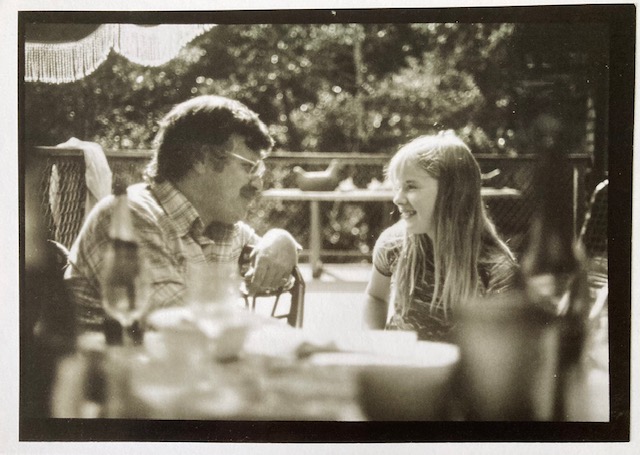 High-res version
High-res version
P: 24 – 25 September Boulder/Albuquerque – “Europe wasn’t far enough,” L. said to me. We had been roommates at Oberlin. She’s now a lawyer. As everyone knows, I didn’t become a lawyer.
“Yes.” Europe hadn’t been far enough. I had been preyed upon and abused and even manipulated in absentia by my mother. God knows what degrading information she said about me to people after I went no contact. And before I went no contact, God only knew the entire range of stories she invented about me to promote her own ego. However, to make sure no one would talk to her family members after her death, I do know (via written testimony) my mother claimed that at least one family member was a stalker, and the family member in question is far from a stalker.
The list of people who actively abused my family “by proxy” with my mother’s “heavenly” blessing and/or wouldn’t talk to me after my mother’s death boggles the mind. One person texted me that she was going to file a police report on me after I extended open and friendly and private communication (via her published online work related email and leaving a message on her voicemail on her published telephone number as a follow up) and received no response. Until she threatened me. Considering that she was sitting in Norway and I was, at that moment, in the Netherlands, I felt the woman must be delusional. Basically what’s talking is the fear that my mother whipped up in the people with whom she came in contact and this has been the greatest obstacle when trying to communicate with people. Either that and/or my mother collected a group of mentally unstable people around her who would do her bidding and who could be easily manipulated through her intelligence and charms. And she’s dead now.
L. and I were sitting at a cafe in Boulder. I sure as hell hadn’t wanted to go to Colorado but it seemed inevitable and I had come around to it. For the meeting with L. I had just driven back from Longmont, the place where my mother committed medically assisted suicide (no family member was involved or informed) two years after she instigated my father’s demise. I hadn’t seen that house (1046 Grant Street) since 2003-ish and never wanted to see it again. But standing in front of it, I didn’t feel much of anything. Just a slight tightening across my chest, which seemed manageable and I had an agenda to get through. To me it just was an effing miserable place where my father suffered ill treatment by my mother. The moments of madness living in that house with my mother show up in his letters, and I have read the ones he sent to me, his friends and other family members. He thought he could handle it. And, yes, he found joy in his world and he chose his life. Maybe not the ending.
L. and I hadn’t met in person in over twenty years. But it felt like we had seen each other yesterday. Of course, using the most succinct emails possible, I have been peppering her with questions regarding Colorado law for the last three years. After our three hour meeting, I drove back to Longmont. I wasn’t staying in Longmont. I had made a strategic request for an airbnb at an organic farm and my request was denied. More fear at the sight of my name? I suspected yes. In any case I freely admit I felt better staying in Boulder.
Standing in front of Terry Stutzman Mast’s doorbell, I rang it once. I was alone and no one was home. I left a note. She must have caught it (all the “drama” of me on her front porch) on video. All I want to know is what Terry and Eldon Mast did with my father’s missing archival materials. I have no interest in the financial deals they made while flipping the house at 1046 Grant Street. I couldn’t care less about the house or their inner workings with the real estate market in Longmont.
“What is that?” I had asked my friend while in New Mexico. We were in the car and just outside Gallup. The road was parallel to the train tracks.
“Old military fort.” C. said, nodding at the rows of the earth covered igloos. “Polluted site.”
I gazed at the Wingate Ordnance Depot. During the Manhattan Project the depot supplied one hundred tons of explosives for the first atomic bomb. The land is ancestral land to both the Zuni Pueblo and the Navajo Nation. Environmental remedial work is continuing on the site to make the land safe again. And when I say again, I mean as in prior to 1864 when the US Army used the base to promote the forced incarceration of members of the Navajo Nation on the reservations, subjecting hundreds of people to starvation, which was then followed by the installation of the weapons depot and the release of hazardous substances on tribal lands.
“I nearly stepped on a rattlesnake,” the man had said at the picnic, describing how he was so busy hitting the branches of the pine tree to shake off the piñons that he hadn’t noticed the snake by his foot. That day I had been invited to join my friend’s family gathering on the Navajo reservation. “I heard the shhhhhccchhh and I looked down,” he continued.
“Yeah, this guy,” a woman sitting at the table informed me, “is Sioux.” She jerked her head up at her husband.
“This guy!” Everyone laughed
“Been here so long sometimes I forget Lakota words,” the man said. “My sister calls up, she lives in Germany, and she asks me how do you say this and how do you say that, and I just tell her to say it in German. No one will know the difference,” he joked.
I had flyers printed up. I passed them out on Main Street in Longmont. I stuck them on poles, I placed them in mailboxes.
On my way back, driving south, I decided to visit Naropa University where my father taught for many years. I had never been there, and I walked right past the campus. I had read that Naropa was selling off the property and planning to teach online and I had imagined that the location was larger. When I backtracked and found my way to the cluster of buildings, I found a group of people in the courtyard, working on a sensory experience. One person had their eyes closed while another person led them around the courtyard. It made me feel sad. This was it, the place my father had managed to get a job that related to his lifelong love of words. He loved teaching, he loved his students. And it all ended in a lawsuit that was just another of my mother’s narcissistic tactics to separate him from the community that supported him. And then: what happened to his literary legacy? What had she done? What had Eldon and Terry Mast done with Keith’s imagination, the only thing he had left?
As I was rolling past the northern hill country of New Mexico, I took note of the Anglo homesteading houses. “A box car,” I mused, “seems like a good idea for the backyard.” A large storage container that could come to a full stop in the back garden, enacting the idea of manna from afar, an undeniable thirteen feet tall cargo load that somehow schematically fit into a pleasant picture.
I decided to pass by the Santa Clara Pueblo on my way back south. To my surprise just before it got dark, I was still driving around winding roads in the hill country. I could have sworn that the pueblo was on flat land. Suddenly a sign appeared: Road Closed. I turned right and went down a dark and dusty road. It wasn’t much of a road. I checked google maps. This detour added twenty minutes to the trip and it would take me to the pueblo. I wasn’t very happy at this point, but the deer bouncing in front of my headlights were easier to navigate than the traffic in Denver. By the time I got to the turnoff to the main road, I felt I didn’t need to go see the pueblo. I rolled down the window and inhaled the air. The smell was slightly familiar.
“Damn it,” I thought once I arrived at the airport the next day. The flight left at 11:00 am and it was Delta. That meant lunch on board was a diet coke and the apple from the hotel’s breakfast bar. I sat down at the cafe near the departure gate and ordered a breakfast combo. The hashbrowns were pretty good, if I do say so myself.
I am real. I have family. And my father is in and with me.
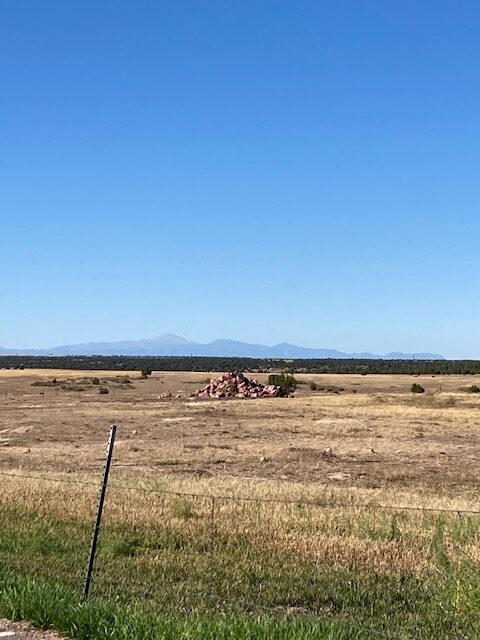
22 September Gallup/Farmington – Having explained a bit of the purpose of this long trip of mine, my friend and her husband agreed. I should leave on the Sunday afternoon and head north. I was completely unsure of what I would achieve but, right on time, I was back in the mini van and heading north towards Farmington. I listened to the Navajo radio station as I drove. Three days with my friends had re-energized me. As I barreled down the highway, encouraged by the singing and drumming I was hearing, I was more than ever aware that I needed to participate and celebrate my own heritage because that is where I come from and, in part at least, belong. I had located, to quote the guide from Acoma when she was talking about her people fighting off the colonizers, within a discouraged heart a courageous one. That phrase from the tour had stuck in my mind, how to fight for my father’s legacy and create my own?
Before I departed the twenty-two year old son of my friends spoke to me in length about the intricacies of team roping. I had never given much thought about the matter, but there I was listening to explanations and terminology linked to chasing and roping a cow within mere seconds. One member ropes the horns while the other team member prepares to catch the hind legs. I kept thinking that if I could remember any of the terminology, I might write a clever poem or, more likely, a not very clever poem. There’s a definite danger when welding words from one world onto another.
A billy goat was roaming around the yard, down near the horses.
“His name is John.” My friend explained that her son had informed his parents over the phone that he’d traded equine dental services for a roping goat to practice on. Afterwards she discovered the new animal in her yard was, in fact, a goat with long curled horns, a strong odor and a temperament. “He’s out of the pen again.”
“Why do you keep him in the pen? You should let him out,” her son chastised his parents.
I watched as my friend’s husband guided one of the horses out of the enclosure. The horse was not wearing a bridle or rope. V. stuck out a hand in one direction and the horse got right to work and corralled John back into the small pen. John didn’t seem to mind much. He looked towards the house as he munched on some straw. The horse calmly walked back to the larger pen.
“You went lowriding?” C. exclaimed after I told her about my Espanola experience. “That is so northern New Mexico.”
The next morning in Farmington I met up with P. When I last saw her, she was ten years old. Now she’s taller than me and an ex policewoman. She has a full time job and often travels for work. When I was fifteen and first visiting her mother’s home, the house was full of children. There were at least five or six girl children in the house and we all slept in the back room. The boys were at the grandmother’s house and we had to wait until they were away from the outhouse to go use the toilet. Every once in a while the grandmother would come outside and tell them to stop hanging around the girl’s outhouse area.
“You didn’t get the traditional religious experience,” one of C.’s aunts remarked to me at a family gathering on the res. “Everyone here is Christian.”
True. My host family is Christian and I went to church with them on Sundays. The service was in Navajo and I was welcomed in Navajo. My host mother still attends revival meetings regularly.
“She thought it was the circus,” C. said of a young family member as we drove by a striped tent standing on a parking lot. One thing I can say is that I have never attended, in this lifetime, a revival meeting.
P. told me about reconnecting with the paternal side of her family who follows Navajo traditions. “I was going to put flowers on his grave,” she said, “but they said that when someone is gone: they are gone.” No flowers.
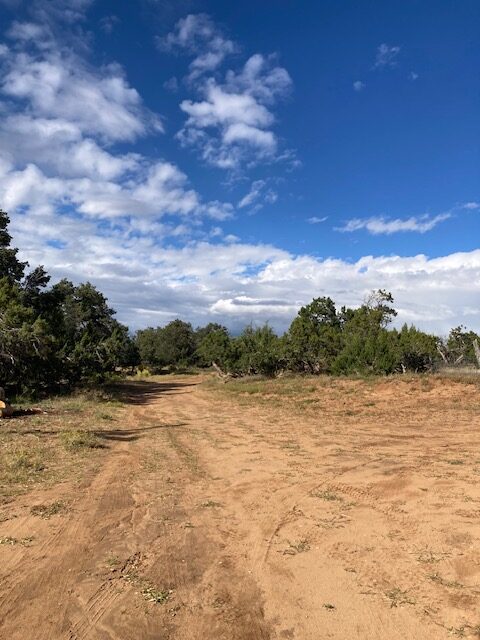
20 September Albuquerque/Gallup – “Maybe,” my friend suggested over the phone, “you should go to the Pueblo Cultural Center while you are in Albuquerque.” I had been considering it. Ever since I landed in New Mexico and started thinking about my experiences as a teenager during the cultural exchange with the Santa Clara Pueblo, the word “pubingheh” had been circling my brain. What did it mean?
When I was young(er) and my brain was more flexible, I almost picked up languages by osmosis. After two weeks on the pueblo as a guest (my second time as an exchange student in New Mexico after one participant dropped out and I filled in), when someone asked to be passed the salt in Tewa, I picked up the salt shaker and passed it down the table. It’s part just being hyper aware and being open to sounds. “Pubingheh” – a word that I couldn’t remember what it meant exactly and I finally googled it. It means the plaza or more specifically the heart of the pueblo or earth. It’s the main spot, and it’s in some traditional ways off-limits, just think of the sacred meeting places, the kivas.
Of course, people had nearly jumped out of their skin when I passed the salt back in 1984. Maybe they began to suspect that the anglo girl was secretly studying Tewa. No such deal. Recently I have – through Duo Lingo – taken another look at the Navajo language. Out of curiosity. Navajo (or Dineh) is a very fluid language because of intonation and variations. If someone had said, “pass the salt” in Navajo to me, it is doubtful that I could have figured it out. Further, if someone had said the phrase slightly differently or with a humoresque twist to the words so that the sentence might have intuited something more indirect, I would have certainly been lost.
After I visited the Pueblo Cultural Center in Albuquerque, I met up with my old friend in a small town just outside the Navajo reservation she grew up on. She and her family live on a (non reservation) property with a couple of horses. Having reread a bit of the journal I kept back in 1983 of the time I spent with her family on the reservation, I joked with C. about my then obsession with the notion of visiting the Acoma pueblo. At fifteen years old and as a guest of a Navajo family, I kept asking about going to the Acoma pueblo which is a totally different tribe. I believe that the attraction was the idea of pavement. Instead of a rural life, the Navajo way of life, the people on the pueblos live in villages (pueblos) and at fifteen I was fascinated (and still am) by architecture and settlements.
“Let’s go now!” C said, after she taught me the Navajo words for porcupine and car. She had never been to Acoma either and she lives quite close. We had an excellent tour of the Sky City and it was an amazing place to visit. The drive down into the valley was spectacular.
Earlier in the week we drove out to the “res” to visit her mother. “I thought you would be taller,” B. said to me as we got ready to leave. Her advice: don’t look for pinons after it rains, they all become dark and you can’t tell which ones are the good ones.
“How much do you get per pound now?” C. asked her mother. Some people were saying fifteen dollars a pound. And a whole bag would sell for two thousand dollars in Santa Fe. Well, that would be just about right considering the kind of customers hanging out in Santa Fe. We climbed back in the truck, our pockets filled with the pinons we had gathered, and started back down the dirt track to the main road. (Photo: me in my sombrero taking a photo of the church on Acoma).
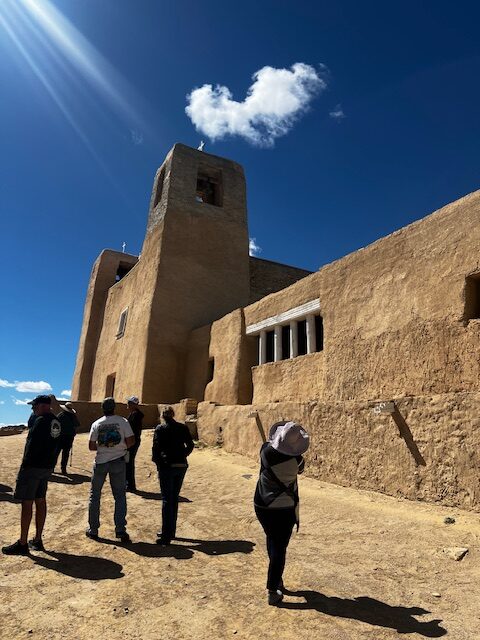
19 September Albuquerque – I arrived in Albuquerque fairly exhausted. And I decided to sleep in except I wasn’t sleeping. I had some decisions to make because the last days of this trip (this trip of a lifetime) are unplanned. Are, as yet, still unplanned. And these decisions are exhausting me more. I wrote several emails and, while waiting, decided to get out of the house. Given this enormous white minivan that I am driving, I also thought it best to take it out for some small time touring before I hit the road.
I headed for the Albuquerque Museum and was blown away by the exhibition entitled Vivarium. Artists: Nathan Budoff, Patrick McGrath Muñíz, Steven J. Yazzie (Diné/Laguna), Eliza Naranjo Morse (Tewa, Kha’p’o Owingeh), Stanley Natchez (Shoshone-Tataviam), Julie Buffalohead (Ponca Tribe Indians of Oklahoma), and Eloy Torrez. The exhibition also includes a selection of works from the Tia Collection including paintings by Nanibah Chacon (Diné/Chicana), Julio Larraz, and more.
What caught my attention the most was the paintings by Steven J. Yazzie. The ones where the coyote runs the show in “End of the Blue Sky”, “Death of the Curator No 3” and “In the Twilight”.
I stood there in front of these paintings and thought about my parents. My father who studied and adapted and became an adherent to the De Soto Zen tradition, fading off into a silence. And my mother who, as we sometimes joke in the family, was the elusive “Jewsami” with her fantasies and fabrications. It was quite the scene at home. Coyotes, in a way. Irreverent, aggressive and yet following their own nature. Nothing is sacred.

After the museum, I decided to check out a small second hand shop where I discovered a manuscript tucked inbetween the books on writing. As my mind is fixated on finding my father’s missing manuscripts, I counted out twenty-five cents and rescued this one. It’s called “Wanting Milk” and the author is a woman named Christine Dumaine Leche. The manuscript dates from the early 1990’s. I opened it and read a poem. Betty’s Motor Lodge, written the day after my father’s death. I wish I could rescue my father for a quarter.
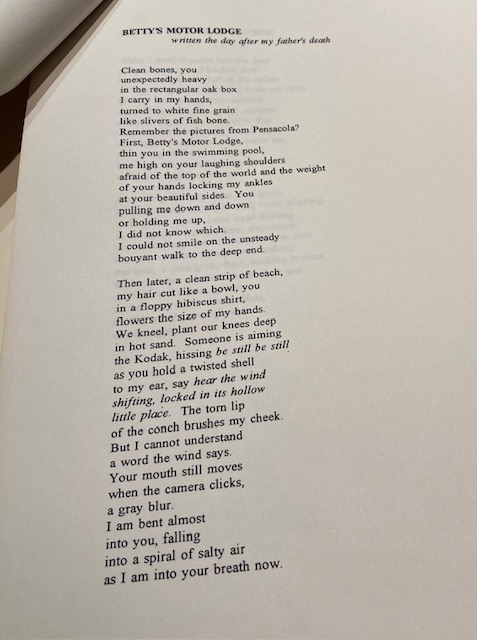
18 September Albuquerque – I can’t even remember how I got there. I certainly didn’t rent a car or drive. Bus? Where? When? It’s such a vague memory. It must have been late winter 1988. I was failing college and I flew to New Mexico for an ethnomusicology project in which I had no idea what the heck I was doing or talent and hardly any real interest. Somehow along the way I stayed with a photographer/poet friend of my father. Was that in Santa Fe? Her name was Martha Wolfe, or Wolf or Wolff or a combination of possible letters. I googled versions of these notions this week and came up with a face that seemed familiar and far too young.
During my short stay with Martha, she offered me her couch and ear, listening to me babble some of my own nonsense or present some mambo jumbo ideas that had been installed in me. I wasn’t very coherent and tried my best to say what I had learned was expected to be said. I was pretty lost. Martha asked me a question and then, at my reply, said something along the lines of, “I am not sure about all that.” But the remark that stuck in my mind all these years was that Martha’s extraordinarily beautiful daughter (I was shown a photo) was the subject of Dennis Hopper’s own photographic and artistic aims. Maybe more, but anyway the feeling wasn’t mutual on any of the options. Martha’s teenage daughter had finally turned around to face Hopper and screamed, “Stop following me around!”
My parents keep contact with the pueblo family where I was an exchange student back in highschool. The program paired two highschool students from different backgrounds and we spent a month together, two weeks per home. At the pueblo in New Mexico the host daughter was a person engaging in very different activities than myself and we did not see eye to eye. But, unlike me and later on, my parents kept showing up in Santa Clara.
During this cultural exchange on the Santa Clara pueblo in the 1980’s I famously spent one afternoon in the backseat of a souped up vehicle, lowriding up and down the main drag in Española, because my host sister wanted to “hang”. I thought the whole afternoon was tedious beyond belief. Not even the big furry dice dangling from the rear view mirror cheered me up. Nor did I want anything from the drive-in. During my stay I was overheard rehearsing in my room, tackling my lines for a presentation or play, astonishing my host mother with dramatic sentences from Shaw or Shakespeare. She and her husband were lovely people and my acting ambitions, forcefully enunciated from behind the closed door at the end of the hall, were obviously amusing for my host family. A family whose own standard of living was stable and well above that of my parents’ economical status.
It is still perplexing what New Mexico really means to me. The exchange I spent on the Santa Clara pueblo was the second exchange that I took part in during highschool. During the first exchange I was hosted by a Navajo family. I have very fond memories of this period and am still in contact with family members. It’s the reason I returned to New Mexico.
Still, I have to ask myself what this “Berkeley education” (if you want to call it that) that I received has impacted my long term life views, as well of the trauma of being separated from my family members in Washington State and being presented with a diversion situation, akin to what Cousin A. remarked to me this summer in Seattle as the, “Will you be my new grandma?” idea. A situation in which Native American culture was glorified in the home I grew up in because it was “better than” the white people’s world.
My parents never met anyone from my host Navajo family other than my host sister when she was staying at my house and I was playing the role of the host sister. My parents probably never arrived at her family address because finding the location on the reservation would have been a challenge. Turning off the highway onto a pueblo is much more straightforward. And the question in my mind is, “Would they have wanted to herd the sheep and collect pinons?”
But they did show up in Santa Clara where my host father was a policeman (and navy veteran). Considering my father’s drug habits and dealing past, I am quite sure that he did not deliberately set out to make friends with any law enforcement officers. But there they were, again. My host mother was a potter. Ah, you might be getting the picture.
Over the years I’d received letters from my parents and just this month I read the letters in the archive in Bellingham which again refer to how my parents valued visiting the Southwest and Native American cultures. And what happened to the northwest? Yes, they visited the Native American cultures in the north as well, even during the period when I was forbidden to go to visit my family members in the northwest. The fact that my parents paid out money to visit Native American culture in Washington State while I wasn’t allowed to visit with my flesh and blood living in Washington State still hurts. Deeply hurts.
When I departed the states for good, I left the beautiful Santa Clara pots my host mother had given me at my parents’ house. I didn’t need to take them with me, I didn’t feel worthy of them, and I never asked for them back.
16 – 17 September Seattle – “Well, would ya look at that!” Step-Grandpa Art used to say. He could have been indicating Mount Rainier in all its splendor or the neighbors repaving their driveaway. “I’ll be darned,” he would mutter when I drove the big black van around Federal Way, “they put up another housing complex. Used to be….” On my way to the airport I drove by his house. Since the house was sold all the rhododendrons have been pulled out. The place looks tidy and well kept. A far cry from the backwoods of South Tacoma and high on a bluff, the address is near enough to walk a short block and gaze over Commencement Bay or get a good view of Mount Rainier in the distance.
Taking the long route north, in other words first dipping south, I went past the old Abbott farm. It’s on a dead end street now and the house and grounds don’t look very appealing with all those rvs and trucks parked in patches here and there. Cows used to graze in the field. No one in the family wanted to drive by, it hurts their hearts too much to see what became of it. My father grew up on this farm, left this farm and never went back. Aunt J. and Uncle T. took over the property when Grandpa Len began a business of his own, X-Cel Feedmill, and moved with Grandma Gert into a residential area. Keith liked his garden but he wasn’t suited for farm life and was unhandy with tools, especially carpentry gear.
“You knothead!” Aunt J. exclaimed. “Dad used to say that.”
She handed me some corrections to this blog. “Do you think,” she asked me, “that the bowler hat was because of Abbott & Costello?”
We had previously discussed how trying it had been to get through school back in those days without being teased. “Hey Abbott! Where’s Costello?” No one would remember much of the comic duo these days.
I checked online and read that it was Costello who wore the bowler hat. Keith had worn one throughout his younger years as a poet. I always thought Keith wore a bowler hat because his friend Richard Brautigan always wore hats, particularly western style ones. But maybe The Abbott was just switching roles and getting in touch with his inner Costello.
I learned from Keith’s friend G. that my father refused to go out to do a bid on a hauling job without his bowler hat. I wonder what kind of impression my father made in the mid 1970’s showing up at people’s doors to cut their trees and clean out their garages in Berkeley wearing a bowler hat above his mustache. Perhaps he would succinctly explain that he was a poetic trash hauler, thinking that would soften people’s wallets. By hiring him, customers would be supporting The Arts. And if customers didn’t pay up, he’d block their car with the truck, ring the doorbell in greasy “coveralls” (as he called them) and smiled his best smile as he leaned in the doorway, resting one large beefy arm and meaty hand against the doorframe. In a way, pure poetry.
Flying out of Seattle my plane circled wide in the air, avoiding the storm clouds in Utah. Flashes of lightning shot down to the earth in the distance, a smoky blue black haze lay thick over the land. A passenger congratulated the pilot as we disembarked in Salt Lake City. “Well, the good news is we were supposed to land here. A few other planes were redirected,” the pilot smiled.
“Betty was mean,” Aunt J said of the neighbors’ children. “She bit Keith. He would just let anything happen. I was lucky and had her sister to play with and Keith was stuck with Betty. I still remember Betty’s face when Mom said that she would pull all of Betty’s teeth out if she ever did that again.”
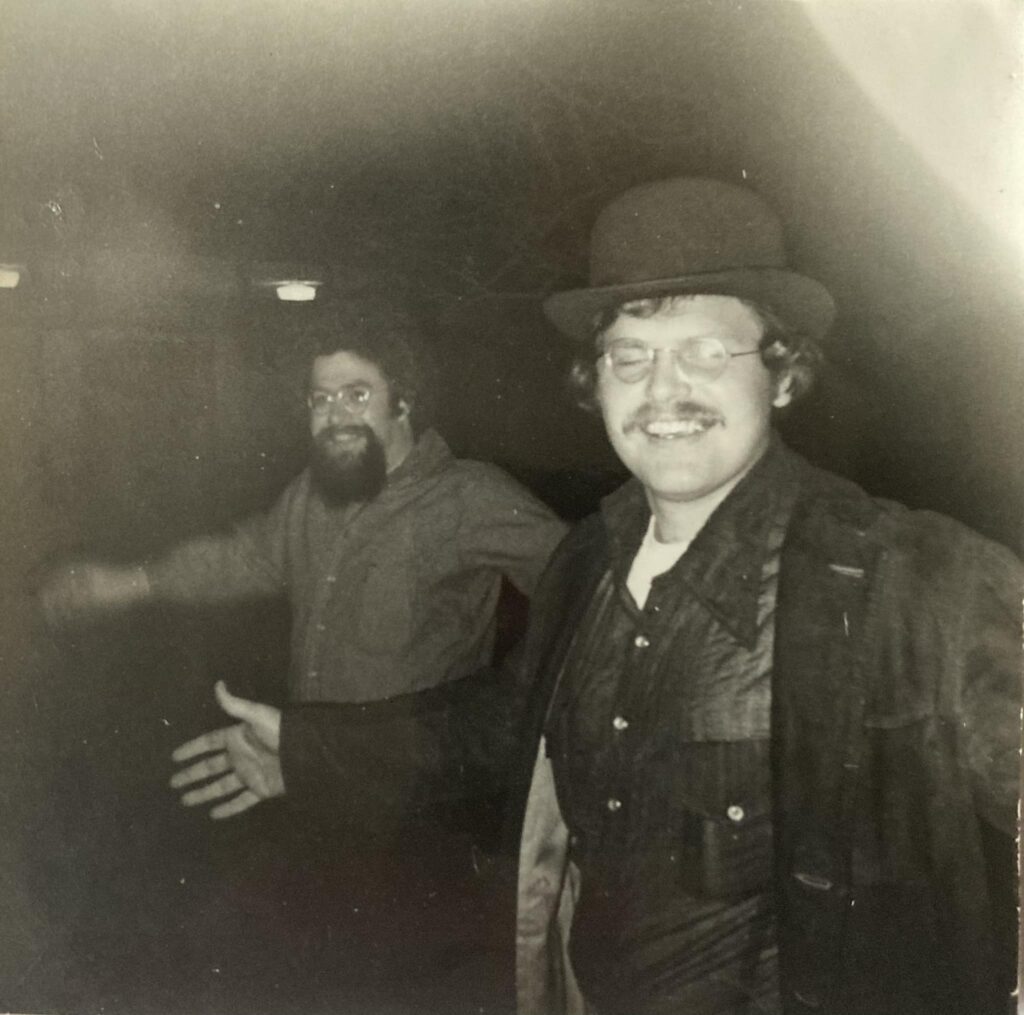
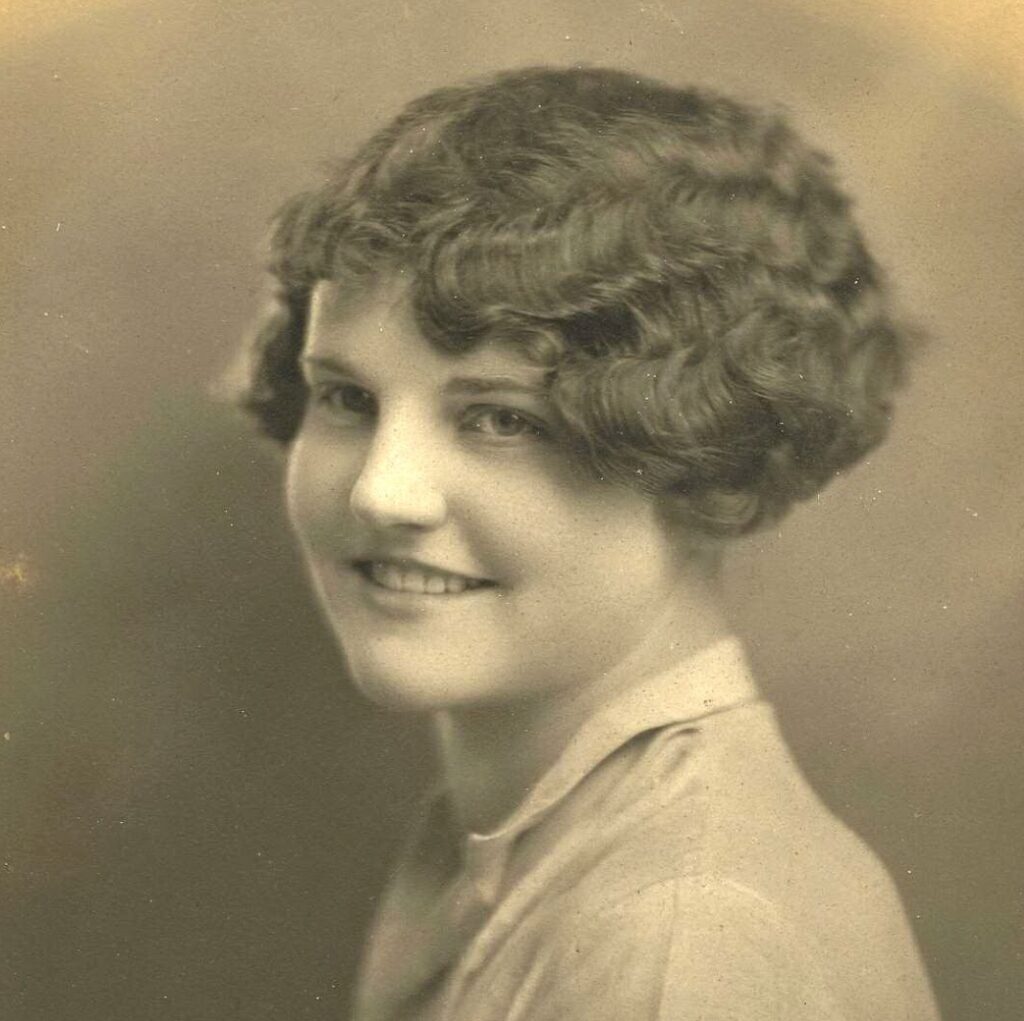
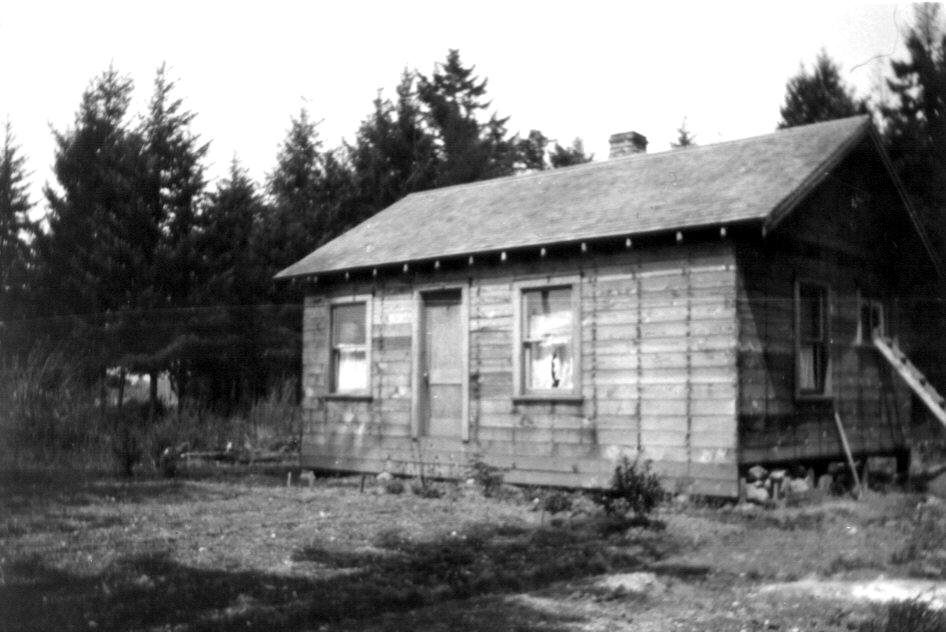
15 September Tacoma – “You’re wrong,” Aunt R. said to me via Messenger, “that was Tressa’s church. Mom went to Trinity Lutheran.” Someone was paying attention! Appreciating the information, I corrected my blog post about the Bethlehem Lutheran Church which I attended on my first Sunday in Tacoma. I also noted that this new plot twist would mean that I would be back at church on my last Sunday in Tacoma.
Pulling up to the front of the 1958 building, I recognized it. Grandma Hannah had taken me once to a service and she was terribly anxious when we left. “Did ya like it?” she asked as we walked across the parking lot to the car. I must have been about eleven years old and I was on my summer vacation. My parents were not open to the idea of Christianity whatsoever. I said that I thought church was okay and I knew in my heart that the right answer (back in California) was that church was a load of hooey.
In my memory the interior of the church was yellow-ish but in reality it wasn’t. Varnished wood and exposed brick are presented, an unobstructed view given the height of the walls and ceiling, to the attendees. But, safe to say, the wood is glowing.
Sitting in a pew in my navy blue easy-travel polyester trousers that I recently bought in April in Palermo (elastic waistband and made for people with short legs) I could definitely see why Hannah preferred Trinity Lutheran Church over the Bethlehem Lutheran Church in town. It was light and airy and modern and far from her badly behaved mother-in-law, Tressa. Waiting for the service to begin I thought it was fitting that I was wearing polyester trousers. Hannah used to wear them often, polyester pant suits were all the rage back then. And they had elastic waistbands and I definitely was feeling the benefits of this facilitation.
“I have never sat on this side,” the woman behind me said to her friend.
I surmised things were getting dicey this morning for the ladies.
“Hannah used to find comfort talking to the pastor for advice,” Aunt R. had added. I was glad to hear that Hannah could speak to her pastor about her trials and tribulations.
The pews were too deep for me. I went to find a cushion.
“I don’t think,” I said to myself now that I had some back support, “that Hannah could have ever comprehended what was happening when my mother broke contact.” But then no one did. And the shunning and bewilderment went on and on until I finally broke the silence seventeen years later.
It seemed that after I was born Great-Aunt R. had visited my folks in San Francisco during the late sixties and reported back to her sister Hannah about the drugs, “Get her out of there!” Highly concerned, Great-Aunt R. was talking about my mother to my grandmother.
Musing on the situation, I must say I really don’t see that much difference. Grandpa Lloyd was an alcoholic struggling with PTSD and my father had a drug addiction and struggled with anxiety. My father also had anger issues which he managed to keep under control. However, neither home scenarios were healthy and there was always some danger involved when it comes to the behavior of family members with substance issues in a home and both sides of my family reacted.
Of course, given the ample supply of drugs (Keith always had a dictionary of medicine on his desk) at home, I could have easily fell victim to drug addiction. The plain truth was: I was not interested. Nonetheless and probably worried about this, Hannah could not have guessed my disinterest or foreseen the future.
My immediate future, after the church service, was Denny’s. Hannah would not have seen Denny’s as a threat, but most of the people I know view Denny’s as foe. Denny’s was on the way to my appointment with Aunt J. I got myself a booth and looked at the menu. What I really wanted was the meal I mainly remembered from my youth, and hardly ever ate, which was watery frozen strawberries launched upon a waffle, laying somewhere under coolwhip.
Alas no gluten free waffle. I ordered the 450 calorie “fit combo” which was turkey bacon, egg whites and spinach and tomato with a side of fruit. I dropped the English muffin and went for the hashbrowns, bringing up the calorie count to 12,597. I didn’t care and, would you know, the hash browns were the best I’ve had so far on this trip. I ate the fruit. It tasted like fruit. I listened to the conversations in Spanish around me. I could guess why this particular Denny’s was serving real and freshly sliced fruit.
14 September Tacoma – Aunt J. drives with one hand on the steering wheel. The other hand lays in her lap. It’s a way of driving that makes me think that Aunt J is always driving a 1964 Buick, back when the steering wheels were thinner and more elegant. And wider because power steering wasn’t yet a thing. I’m the kind of driver that grips the wheel with two hands, mainly because I was taught that this was how you drive and secondly because I find driving a challenge and I am still learning my way around any town that you can name.
“What is skunk cabbage?” I asked Aunt J.
We were sitting in the Tacoma Library in the round room. It is a lovely room with marble trimming on the stairwell. We had to make an appointment to go and then, after parking in the back alley, we waited at the loading dock to be let in. The whole exercise felt a little clandestine, but the library is being renovated and closed to the public. Inside we were handed documentation on the development of Tacoma’s industries. It was the topic that Aunt J. and I agreed upon.
“It’s a plant that grows in swamps. I think you can eat the leaves.”
I had heard the name, just like I can easily pronounce the word Puyallup. Or Tacoma with a kind of sliding c sound. I didn’t grow up in Washington but my parents both come from Tacoma, There’s a familiarity about certain names and concepts, despite my lack of actual knowledge or local practice.
“Oh, those old telephone poles,” Aunt J. said looking at a photo from the early 20th century. I looked down at the photo. The telephone poles in the photo were extremely high with many vertical branches making a whole series of “t”’s. “They used to have to string all the wires across, instead of one wire like they do now.”
Looking at the construction, I couldn’t ever recall seeing such a telephone pole in my life.
We discussed the smelter and the coal and the electricity that was needed to power the flour mills and the lumber companies. Afterwards we went to dinner, agreeing on our favorite place. I already had my heart set on the clams. Since the fries were contaminated with a coating, I also ordered gluten free bread and butter.
“Dad always had a beer after work.” Aunt J. said. “When they played cards, Uncle John and Uncle Ed and they would all drink beer. They were total card sharks. Uncle John could read everyone’s hand.”
I hailed the waitress and added a cocktail to my order. The grapefruit and gin “Sunset Harmony on Whose Island Is This in a Sulpher Breeze” or whatever it was called sounded as if it would greatly complement clams.
“Of course, we would find the bottles and set them up in the shed and play saloon,” Aunt J. recalled her wild days with her baby brother, Keith. “And Mom would get so mad. You see, we found them all around, buried in the woods.”
After the first two kids, hard liquor was off the menu for Gert and Len. And officially, no one had been drinking anything alcoholic in the early to mid 1930’s out on the stump ranch with not many neighbors around to check out the revelry. “What do ya want? A sasparilla?” Aunt J. lisped in her best cowgirl voice.
“Has anyone ever told you – you look like Marilyn Monroe?” A man ambled over to our table. “From the side. Splitting image.” He was looking down at me. His skin had a pink hue to it like he had been on a boat all day.
I replied that no one had ever made such a remark to me. “Thank you.”
“She’s alive, you know. She’s ninety but she’s alive.” The captain was convinced of this.
Across the table, I wasn’t sure that Aunt J. saw in me the resemblance of a ninety year old Marilyn Monroe in front of a large bowl of clams.
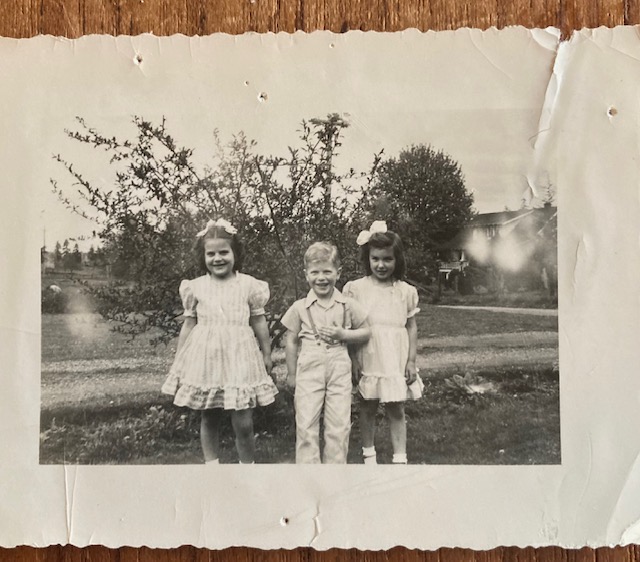

13 September Bellingham to Tacoma – I spotted the Poodle Dog. It’s still in business as a family diner. You might be as relieved as I am. I had driven down the slow way from northern Washington, stopping by my cousin’s house for a short visit on my way to Tacoma. Traffic was congested in Seattle but I didn’t mind really. I was enjoying watching the scenery from behind the wheel real slow-like as I avoided the freeway. The noise driving down I-5 assaults my senses like dogshit stuck on a penny loafer.
I was delighted to pass alongside the train tracks by the Boeing Airport south of Seattle. I really like watching trains. I also admire industrial areas. It’s all the details and methods and sequences of purpose in architecture. After that I was totally enthusiastic driving along the Port of Tacoma, all lit up for the evening, when I clocked The Poodle Dog.
The last morning at the archives, a member of staff pulled the big book on Richard Brautigan by Hjortsberg for example that Keith contributed to, along with many many others. Keith had stuck all sorts of post-its in it, marking sections. But no written annotations. It was very sweet of the archivist to think of this idea.
I have a plan. I feel the spirit of Keith egging me on.
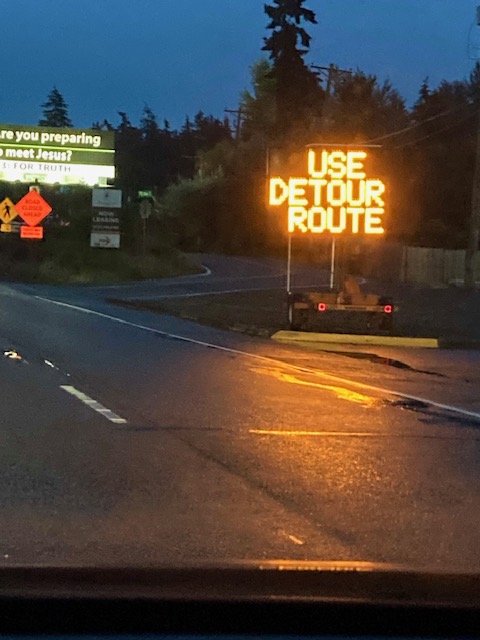
13 September Bellingham – “They probably did,” my air-bnb hostess said to me.
The house I was standing in had been built in 1968. Not long after, sometime around 1970-1971, my parents moved into the neighborhood, right down the street. They rented an old wooden house or rooms in the old wooden house which was part of the poet-artist-student scene. I had just mentioned to my hostess that I had an inkling my parents probably visited her mod house before she ever owned it..
“Initially a couple bought this house, but after the divorce the woman kept it. Patty was quite the partying type,” A. continued. She had spoken with the neighbors, long time residents and living on a family owned property.
“It must have been dirt cheap back then,” I mused, “to live out here.”
I woke up early. I had a lot on my mind. “Oh just get up,” I told myself as I lay in the basement bedroom of the air bnb. “Go watch the sun rise and shimmer over the lake from the east.” Kinda from the direction of Mount Baker. I reflected that my father, always an early riser, must have had many mornings of haggardly stepping out of bed before dawn, and probably still jacked up on all sorts of drugs, to write poems. Or just look at the lake at any time of the day.
Poems from that era:
The edges of the evening have a slight stain on them, as if the person who joined them together was sloppy with his glue. Also the mountains seem a little grayer and more or less frayed. The waves have a sloppy half-hearted look to them, no crisp rolls as they sweep toward the beach which is somewhere out beyond that pink and white house with the green window trim, the cement backyard, that I can see through the scuzzy storm windows.”
(Keith Kumasen Abbott, undated early 1970’s and most likely written in Bellingham, WA)
***
THE WORLD’S MOST PHOTOGRAPHED HOLE
You walk down the street, secretly sliding all the unoccupied floors out from the houses and slipping them into your pockets. The scene inside you imagine: the astonished housewife staring down at her TV set, her sofa, her coffee table and doilies, the complete set of Collier’s Encyclopedia, all in a jumble on the dank dirt under the house.
She was in the kitchen peeling carrots when she noticed a draft, there’s still a limp carrot peel sticking wetly to her right hand just above her knuckle.
(Keith Kumasen Abbott, undated paper type and typeset same as the previous poem)
***
Alright just one more, and this one is from the SF period c. 1968 on Balboa street near Golden Gate Park.:
MICKEY AND SILVIA LOVE IS STRANGE
Everything today becomes a new title for my next book
Army Cot
Sugar Daddy
The Gooiest Alligator or How to Cornhole Walt Disney
When I contemplate, in the good sense,
This billboard lacks sonority
Sparkle and wit, I’m here, once again
And skeins of suicide drift thru the trees
In a fog and holding one eye in a cupped hand
The eye is in my forehead
“Your sweet loving
Oh ah O
Is better than a kiss
Oh Yes”
Here in the shadows of dawn on Lake Whatcom, I watched a blade of clear blue sky cut through the low gray clouds.
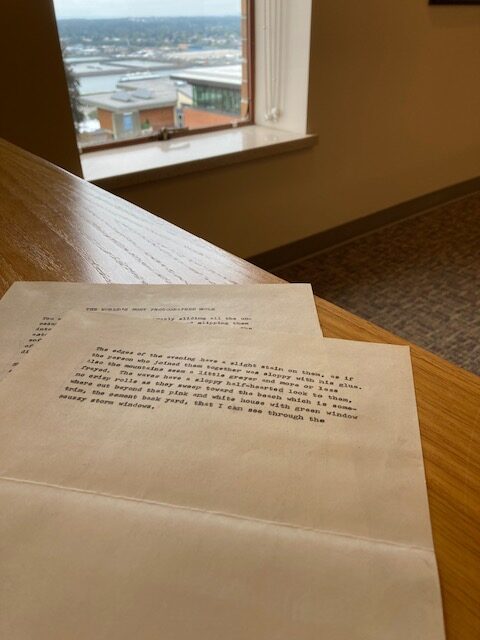
12 September Bellingham- What is Eldon and Terry Mast’s Tribute to Longmont Poet & Author & Artist Keith Kumasen Abbott?
Coming to the end of an exhaustive week’s worth of reading in Bellingham at the University archives housing the materials of Keith Kumasen Abbott (19444 – 2019), I would like to make some points about my father’s literary legacy.
This week has made it painfully clear that, aside the missing journals or notebooks, the the following manuscripts (for a start) are also missing from the archives: Whack Jobs (2007-2009) an autobio piece covering college years, HW2 (2009), “Thelma and Louise Meet Jack Kerouac” (provisionary title) (1998), Good Golly Miss Molly (1994), Boy Scout Cookies (1994), Percy Q (1977), The Secondary Room (1971), Mr Inbetween (1977), False Courage (1981), Arfy Darfy Love (1998), The Second Time I saw Pete (1977), At the Top of the Heap (1970), Francis (1970), Plays: The Nugget (1982), The Sob Machine, The Rhubarb (1971), Reno, Loyalty Oath, Babe Ruth, Screenplays: Spanish Castle, Good, Golly Miss Molly
“It seems that your mother sabotaged the archives,” the archivist remarked to me.
Thankfully poet and author and artist Pat Nolan supplied some examples of my father’s early wit and energy by donating letters Keith wrote to him in the late sixties into the seventies when they were collaborating on the publication of Blue Suede Shoes, a poetry collation that featured many of the poets of the era of the 1970’s. In these letters my father’s genius, his youth, his daring and his hedonism all come through. In my opinion: that is the gold in the archives along with the manuscript (the only manuscript, in novel form, in the archives) for Low Tech Blues.
So what happened?
Eldon Mast and Terry Mast were allowed to purchase Keith Kumasen Abbott’s house after my parent’s death in Longmont on 1046 Grant and with it the contents that were left. The house was flipped for a profit. Eldon Mast and Terry Stutzman Mast also handled the missing archival materials. Their son-in-law states that Eldon and Terry Mast are claiming that the materials were “disposed of” as per the comment on my YouTube video. Further Eldon Mast has made a statement on LinkedIn on September.11, 2024
So what happened?
It could be said that my mother, who unfortunately exhibited malignant narcissistic behavior towards her family members and towards her husband at the end of his and her own life, hijacked the memory of my father and his legacy. There was no obituary for Keith except for Pat Nolan’s online hommage, which was posted months after he died, there was no funeral service or family service. My father’s lawyer filed Keith’s testament months after my mother’s death which was two years after Keith’s own death. My mother did not inform his lawyer of his death. What my mother sent to the archives in Bellingham were boxes of materials that were filled with duplicate or triplicate printouts of emails and/or basically filler material to make up the bulk or beef up the boxes. She was lucid. The notes that she includes as her explanation of “my father’s history” are lucid. My mother’s durable medical power of attorney never had to take over any tasks ever. And after my mother’s own death Rabbi Diane Tiferet Lakein from the Boulder Synagogue produced a eulogy in which, as my mother’s partner, Keith was reduced to a state of infantilism and/or an imbecile like scenario and my mother was extolled. And the eulogy was pre-arranged by my mother and the rabbi has never apologized for the string of putrid lies that she chose to publically pronounce about my family members.
Let me explain the games my mother played a little further with an example, for instance: I was somewhat uncertain what to think about my mother being registered as a Republican when I saw this fact online. She was not, as many would think, a Republican by nature and going as far as registering for the party would not be her normal inclination yet she very much enjoyed pulling the wool over people’s eyes. This particular issue got cleared up for me when I read in one of my father’s letters to his friend, a letter which is at the archives, that my mother’s Republican registration “was paying off dividends.” In other words her registration to the Republican Party was a joke and for personal gain. She registered only for the purpose of meddling which would, of course, amuse her. And you might think this funny, which in a way it could be, but then start to apply it to the synagogue, all the churches she joined, the organizations, the moments when she could display some show of empathy for people and then move in on their lives. As a kind of con artist she had a particular manner and way of developing a cult-like following.
As one of my parent’s acquaintances said to me after my mother’s death, “A lot of people swallowed your mother’s Kool-aid.”
So what happened?
Someone has said to me, “I thought the timing of Keith’s death….”
I am not providing any further explanation. I am 100% certain.
And that leads me to the question: What is Eldon and Terry Mast’s Tribute to Poet and Author and Artist Keith Kumasen Abbott? Eldon and Terry, where are the manuscripts? For example, where is the manuscript, Eldon and Terry Mast, for Arfy Darfy Love?
I am looking for it. More importantly, where is the manuscript for Keith’s autobiography entitled “Whack Jobs”?
11 September Bellingham – “My Dad used to say the only thing machines do is break down.” (Keith Kumasen Abbott quoting his father Leonard Abbott)
Well. True. Yes. Not quite.
After reading a chunk of the correspondence between my father and the poet/publisher/artist Pat Nolan in which Keith so often describes the many physical ailments that he and my mother suffered, I felt a need to go do something radical. I had read many of these complaints before and, safe to say, my parents had bad luck with their individual health as well as poor habits and subversive behavior towards their physical well being. They started falling apart early and their health didn’t get better later.
It could be I was picking up on that same self-destructive trait, but lunch had been rather thin and I had a headache and was hungry. I decided to go to IHOP. I know. But, in my defense, I hadn’t been to an IHOP in about thirty years. I had heard they had gluten free pancakes and I was fancying the idea of eating an entire combo plate to ground me.
Inside a nearly empty restaurant, I ordered. It was early. My plan was to wait out the traffic while eating pancakes and pseudo syrup at IHOP. It was quite lovely to be sitting in a near empty IHOP. It’s a very vacant and cleansing experience and one that I can appreciate.
“Gluten friendly, yes,” the young waitress said when I checked about the gluten free combo. She looked happy. I gathered she was still living with her parents and didn’t have to pay rent with her paycheck. She was that happy.
“So….” I paused. Because gluten friendly doesn’t mean gluten free. I knew I was having one of those “autism moments” when my reality wasn’t the reality of a printed menu.
“What happened to the Poodle Dog?” I had asked Aunt J. inTacoma as I was already thinking about diners when I landed in Washington.
“I think it closed. Pandemic got it.”
So much of my childhood as an only child was following my parents around because it was warm in the golden circle. And I am guessing my reading the archives is in a manner the witnessing of my own independence.
Still, what is the point to have all the correspondence, thanks to the perseverance of Pat Nolan, between Pat and Keith when the unpublished manuscripts and notebooks are missing? What is the correspondence going to shed light on at the end? What’s not there? But I have to say that the early letters and the energy and drive of my father is impressive. He’s young and brash and dares to be himself, going off in goofy loops. I believe the years wore him down faster than most.
It’s like this: my father is missing from the archives. While his friendships are represented, and people loved him and enjoyed his wit and charm and loyalty. While the outer circumstances are cast in the archives, the core, his most inner thoughts and his brilliance in the form of his wrestling like any writer does with writing and unpublished writing is, in essence, missing.
But of course, there is this item which is real and which, in my mind, doesn’t make up the difference because these are supposed to be Keith Kumasen Abbott’s archives. (Photo: note from poet Maureen Owen)
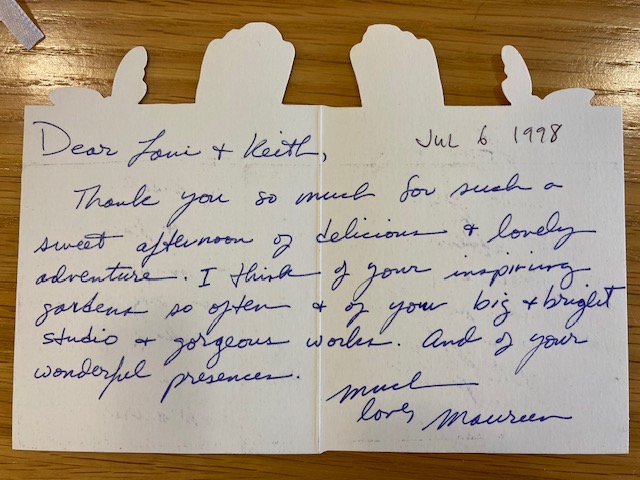
10 September Bellingham – “Michael Sowl introduced you to Blackie Carbone at Beer Springs.” Here in the university’s special archives on the 6th floor in Bellingham I read this poem with interest. Beer Springs is the main focus of socialization (and drinking) in the novel Mordecai of Monterey and Michael Sowl (poet) is the inspiration for Mordecai, the man who stays true to himself despite the ups and downs of everyone around him. Who the heck is Blackie Carbone? Or what is Blackie Carbone? One of those questions that only a handful of people may still be able to answer. The verse continues in my father’s poem and he is the you in the poem, “He didn’t like you. He questioned your draft status and pronounced you a phoney. You were vague.”
Set in 1973 the novel Mordecai of Monterey also touches lightly on the Vietnam War and the feelings of men who came back from military service. Keith wrote at least one poem about avoiding the draft. This poem was published in a small book of poetry. But in the archives there is more material here and there, in bits and pieces my father wrote about his plan to avoid the draft. To my recollection he never really talked about it much. He obviously didn’t want to go to Vietnam and he obviously did not go and he obviously had mixed feelings about his actions with regard to those who went.
Roundabout in 2009, there was trouble brewing and Keith was involved in a lawsuit against his employer, Naropa. I heard some of this and that comments about his concerns re his workplace earlier, between the years 2000 and 2004 or so, and during that time I asked a friend (who happened to be a lawyer living in Boulder) to make a little social call on my parents to find out what might be going on. I was afraid that the words I was hearing might mean the end of my father’s “One Time Shot at a Professional Teaching Job”. She reported back that she thought it was all a minor communication problem and I shouldn’t worry. After this I never heard anything more about this “issue” and later learned, after his death, that he had filed a lawsuit against Naropa and won. I didn’t know any of this because by 2009 I had decided to go no contact. And after the lawsuit I surmise that his relationships with his artistic community and the school were impacted.
Of course, I cannot judge any of these matters. It’s all done and over. And yet reading some snippet from some odd scrap of paper thrown into the correspondence box and written by my father describing how my mother “threw I Ching and what I told her turns out to be right, the person mentioned in the Naropa reading could just well be me, rather than a she. A strange coherence came when the I Ching was asked about NU and the degradation of the school” I can’t help but think, “Great, fucking great.” Excuse the French. This said, my father chose a life partner who was always going to be inspirational (despite the challenges) and as a couple they were celebrated. As for myself as a child, I was proud that my parents were noted for their intelligence and talents by their friends and artistic community.
Reading through the correspondence of the literary agents who represented my father over the years I’ve started a list of the manuscripts that are not at the archives:
- Whack Jobs (2007-2009) an autobio piece covering college years
- HW2 (2009)
- “Thelma and Louise Meet Jack Kerouac” (provisionary title) (1998)
- Good Golly Miss Molly (1994)
- Boy Scout Cookies (1994)
- Percy Q (1977)
- The Secondary Room (1971)
- Mr Inbetween (1977)
- False Courage (1981)
- Arfy Darfy Love (1998)
- The Second Time I saw Pete (1977)
- At the Top of the Heap (1970)
- Francis (1970)
- Plays:
- The Nugget (1982)
- The Sob Machine
- The Rhubarb (1971)
- Reno
- Loyalty Oath
- Babe Ruth
- Screenplays
- Spanish Castle
- Good Golly Miss Molly
But to end this post on a positive and witty note or two of Keith’s in his own spirit and words:
His idea of chair
was firmly under his butt
***
(excerpt on writing)
It’s great to be back in childhood
and only half of your brain there
the other half uselessly seeking here
word after word
on this big white image
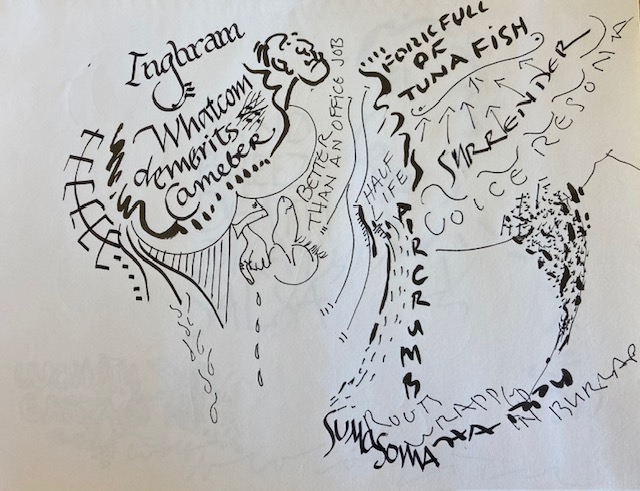
9 September Bellingham – I don’t know what I was thinking. I thought I would like to stay on Lake Whatcom near where I lived for a short time as a child in Bellingham. Instead I dreaded arriving and wanted to leave the moment I got to the air bnb. It’s been three years since I arrived in Bellingham on a chilly evening, for a two night stay in a crappy motel which is why I decided to get better accomodation this time round, and I left during a stormy afternoon. That was in 2021.
I remember the house we lived in before we moved to Bellingham, WA. That house I better remember and it was in Church Streton, in Wales, United Kingdom. I am assuming, now that I have examined photos, that when we returned to the states I most likely stayed a bit on and off with Grandma Hannah and Grandpa Lloyd in Tacoma. Probably while my parents looked for housing and during the time my father started working on his master’s degree in Bellingham in 1971. In any case, I don’t have much memory of Lake Whatcom except for one moment when my mother thought I’d like a canoe trip. I didn’t care much for that idea and I do remember being very vocal about it. Truth be told, being alone in a canoe with my mother is still a rather terrifying thought.
There also was that certain Lake Whatcom story about a babysitter and my parents returning home to find the babysitter wearing my dress around her neck and waving a knife. And….I guess that I am getting the picture that I am not going to recall much positive about Lake Whatcom. The oddest thing in 2021 was that I instantly recognized the house when I turned off the main road in search of the address. In fact I still recognize the older houses in the neighborhood. And I recognize the road leading out of Lake Whatcom, heading south. I had a strong sense of deja vu in 2021 on that road and during this trip, heading over to BC, I actually drove a piece of that road and, again, the feeling of a road already travelled.
I read through the poems (sent mostly in triplicate and higgedly-piggedly so it looks like a lot but it’s not and I turned all the pages of the entire pile despite the encountering the same poems again and again) and between the older sheets, was this item, unsigned and undated. I am not sure what to think. I googled the text and do not have a match.
I once asked my mother’s executor whether my mother had treated Keith well in the last years. It was my hope that she had.
There was silence on the other end of the phone.
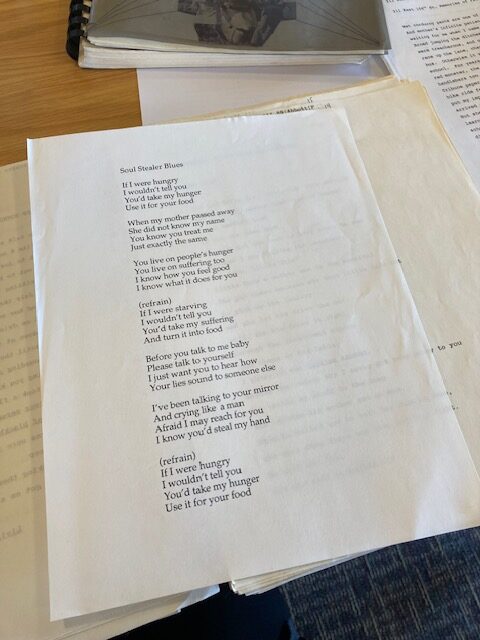
8 September Abbotsford – “The Harms family had connections to the Sommerfeld group,” the researcher had said. I couldn’t stop my reaction. I was clearly startled. I had heard about this ultra conservative group. That might have something to do with Great-Grandma Kae’s extra deep attachment to the Gospel.
I thought about not going to a Mennonite church on Sunday, but then I decided to take the plunge. Looking online I saw that nearly every church in the area had a picture of someone playing an electric guitar, jamming on the altar. I selected the one church that did not have someone playing an electric guitar, jamming on the altar.
Leaving the air bnb and turning the car around to head out of the dead end road, I noticed a bear had ripped off the wooden door to the trash container shed by the driveway of the house. It wasn’t a very solid trash container shed. But then neither were any of the houses. Bears happen to be much more solid.
If I went to church, I had to explain who I was and where I came from which was one of the reasons I had considered not going to church. I just wasn’t feeling up for the interaction. However, I put on my best face and parked the car in the parking lot which was almost filled to capacity. When I stated that I lived in Amsterdam, the woman in the lobby exclaimed, “Meine Güte!”
I was lucky on this Sunday because the choir had just returned from their break and a luncheon was being served in the basement after service. I slipped into a pew on the side of the sanctuary. The Clearbrook Mennonite Brethren Church in Abbotsford has a rather aged congregation. I would estimate that eighty percent of the people sitting in the pews were in the range of seventy to eighty years old. The service began with the singing of hymns and announcements. When the singing began, the harmonious quality of all the voices in unison was wondrous. As was the four part harmony. It had been a long time since I attended a church where people sang four part harmony. (Those blasted powerpoint presentations of the hymn lyrics never include the sheet music and everyone always tends to just sing the melody.) But not only were the harmonies strong and vibrant, everyone in the building was singing in complete accord with each other. In other words the sound was expertly blended.
The sermon was a “can’t take it with you” message and a suggestion to make an “investment for eternity” or a cost-benefit analysis for the inevitable future. I decided to stay for the luncheon. I began to talk with one of the members of the choir and was kindly invited to sit down at a long table that mainly consisted of the choir members. There was some talk of a person in a retirement home.
“He said he saw her and they had a talk.” The person in question had long passed.
“He can dress himself and take care of himself but he’s losing track of time. He was ready to eat lunch at 11 pm. He son said ‘look outside’ and of course it was dark.”
“Why can’t they just let him enjoy a talk with her, and not try to convince him that she couldn’t have come to see him?”
“Exactly. Before my first husband passed, he wanted to sleep in his own bed. So I helped him. I had that hospital bed for him. But I got him settled upstairs. The next morning he said that his sister and mother had visited him. And then he died the next day.”
“People know when they are being called.”
I listened to more talk of going home. It was in a way familiar. Certainly I had heard snippets about this kind of extra sense appearing, perhaps premonitions perhaps telepathic, as a child when I stayed with Grandma Hannah. And here were older people who were talking about death and then finding the comfort of the arms of Jesus. It certainly is a way to go, and a way in which it’s not about the glory of the individual. In the minds of everyone at the table, this fact was the one fact that was guaranteed.
Along with hamburgers and sausage, potato salad and coleslaw salad was served at lunch. Neither of these salads are my favorites but I tried them just because I recognized (from photos) that this was part of the tradition of shared meals and long tables. I was glad that I had opted to attend both the service and the lunch. It was a welcome relief from the hardiness of the visit to the Mennonite Museum.
After lunch I went to what might be called the historical center of Abbotsford. I parked in front of a shop called Spruce Collective where a woman in her thirties with her children in tow was shopping. It was a trendy store with everything and then again nothing available. In other words, not particularly essential. The contrast with the church I had just left was stark. Worlds apart. It was like stepping back into the 21st century. (Below a short video under two minutes of congregational singing, similar to what I heard at the church I attended in Abbotsford.)
7 September Chilliwack B.C.- I was listening to yelling and gunshots as, standing on the top of a mountain the first night, I looked down at the shadows of dusk falling over the reserve lands of a band of indigenous peoples. The stillness of the mountains and lushness of the valley and the burbling of the river lay before my eyes. Around me the lights of the inhabitants of the spanking new housing development shone brightly and the plastic fixtures on the windows and roofs reflected the yellow of the lights.
The next evening I was watching two bears roam around the river. They were small to my eyes, I didn’t have binoculars, but they were wandering up and down a barren island/rocky patch in the middle of the Vedder River. Once they pushed on their course, by crossing the river, a kayaker came moving swiftly past, riding with the fast current. The presence of the bears on the river explained the yelling and shots of the previous night.
This place that I am staying in – yes the view is magnificent but I am listening to the airco both outside on the patio and inside. The walls and ceilings are poorly sound-insolated. The shower pours out water from a gigantic showerhead. And I read that there is water rationing at hand. Is this kind of life sustainable? I doubt it.
“Don’t plug in two appliances at a time……” Advice printed on the apartment’s fact sheet. Around me, the houses are still in the process of being built. I noticed that it was not allowed to park on the slope between November and March. And, of course, every house has, minimally, four cars and parking available for two. It must be a beast up here in winter
In the morning I decided to take a walk. And drove to a waterfall. I was late getting out because all that Mennonite-ness from the day before had tired me out. Once out on the path in the forest, I wasn’t alone. Not bears, tourists. I stopped for lunch at a diner. Waiting for my “sunset” breakfast plate (“for a small appetite” the menu stated), a man reeking of tobacco slid into the booth behind me. He had news: he had cooked up a big pot of corn chowder. Followed the recipe faithfully and then just at the end the recipe said not to freeze the chowder. Now what was he to do? He told his tale to both waitresses separately. “Yes,” one waitress said, “I tried to can tapioca once.”
I was really perplexed by the idea of someone canning tapioca pudding.
The other waitress said she canned borsch.
I paid the bill at the cash register. The waitress told me a joke. Everyday she had a joke prepared for the customers. “Why did the witch….” she asked. I desperately tried to follow some line of thinking, but she quickly gave the answer. I didn’t get the joke. My mind was captivated by the presence of the mineral museum in the next room in which the chairs were still stacked on the tables. It was an exceptional mineral museum at a gas station/diner.
It’s corn season, hence the corn chowder. I drove past the green fields up across the Fraser River, stopping here and there. I made a big loop around, passing reserves along the river and the farms in the valley. The difference is startling, the mineral rich fields freely given to the colonizers, including the Mennonites, and the tribal lands, pushed up against the mountains. Coming back down to Abbotsford I visited the Hazelwood cemetery. I actually visited it twice. The washroom at the cemetery was closed. I made several rounds with the car, circling the Scattering Island and gazing at the ashes of strangers under cultivated trees and shrubs. Finally I decided that I would have to locate a pitstop someplace and found the world’s filthiest 7-11 restroom. Thereafter I returned to the cemetery. It wasn’t hard to find Cornelius and Margaretha who died within months of each other at advanced ages. I was touched. Cornelius was born in Russia (Ukraine) and immigrated as a child to Nebraska. He then moved to Manitoba when he was twenty, married at twenty-two and later relocated his family to Herbert. He chose to die in Abbotsford where family members had come to live. I sat for a while next to his and Margaretha’s grave.

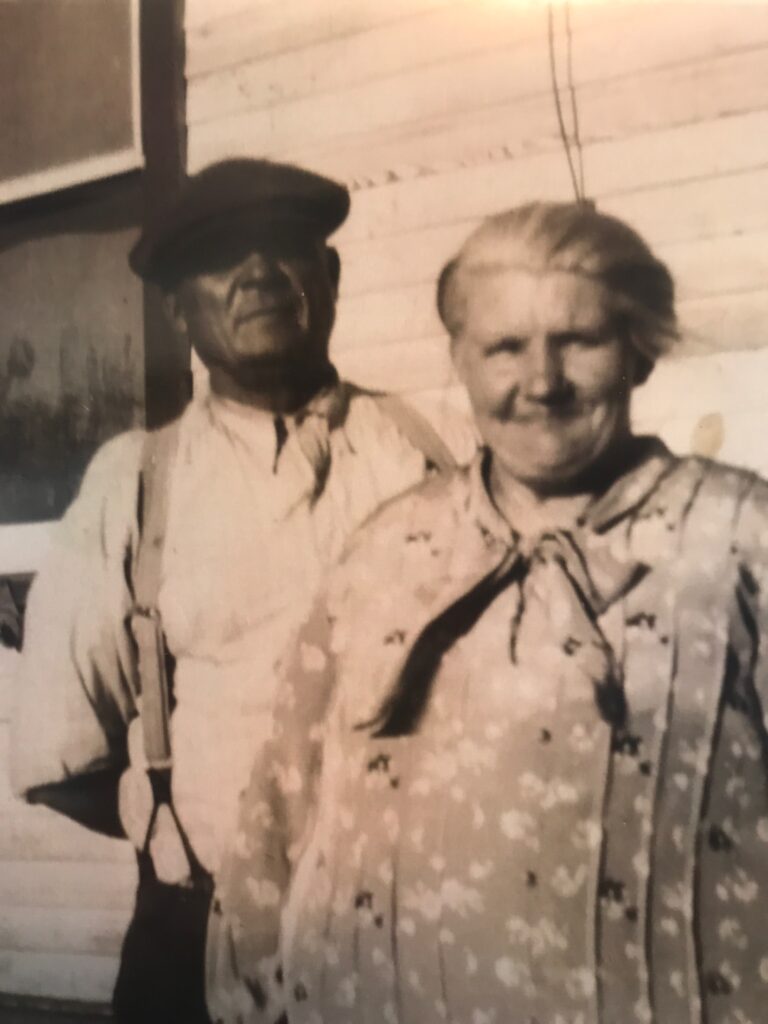
6 September Anacortes/Abbotsford – I had seen the Fernhill Cemetery gates from the car the day before as Aunt R. and I headed toward the seafood store. Something twanged in me and I decided to go visit Great-Aunt Margie on my way out of town. Packed and ready to head east and then north, I first went to the Anacortes post office. While standing in line, I admired the rows of golden colored post boxes (such glowing promise for exciting contents – a letter with news from afar, a catalogue, a postcard, a bank statement, an invoice, a check) and all the boxes clearly labelled with sequential numbers. I even gazed with pleasure at the marble siding on the counters and walls, the framed copies of the Declaration of Independence and the Bill of Rights. I did not enjoy the lowered ceiling (some heresy aka 1970’s “improvements”) that cut off the top of the mural. I also examined the photo of the building just after completion in 1937. It looked perfect.
“You were a child when it happened,” Great-Aunt Margie had said to me the last time I saw her and just before Step-Grandpa Art and I climbed back in the black van. Words of forgiveness that I could not give myself. Hannah and Margie had been close.
At the cemetery I asked where I might find the McDugles. There I was with a man in a golf cart leading the way again. Great-Aunt Margie is buried with Cousin Brn. I noticed that his date of death on their joint gravestone was not the same as on Ancestry. He had died four days past his birthday. Well, there was a relief and a milestone.
I wept. Again, thinking of Great-Aunt Margie’s words. The person I had bonded with, not my mother, I had betrayed. Coerced by my mother, I had shunned my own grandmother. I backed the car out of the cemetery lane and headed out past the casino, past the mudflats, past the orchards, past the grain silos and up towards the mountains. I drove the slow way and arrived at the Mennonite Museum in Abbotsford by 1 pm. I had told them I was coming and I was on the late side.
I was warmly greeted and the afternoon was quite an experience for me. I had never been around the Mennonites in my mother’s side of the family much as a child. Mostly, by the time I set eyes on them, the family members who had left Herbert Saskatchewa weren’t continuing in their lives as practicing Mennonites. The vibe was still present but the lifestyle was not.
“I found Katherine Ratzlaff in Anacortes,” one researcher at the Mennonite Museum told me. There were a half dozen of researchers in the upstairs room. “She was teaching Sunday School at the Church of the Nazarene.” He looked shocked.
Yes, bingo. I wouldn’t mention that Great-Aunt Margie was one hell of a Bible thumping Baptist. Earlier in the week I had cruised through a YouTube recording of a recent Sunday service at Margie’s old stomping grounds, prompting Aunt R. to get up and leave the room. It was astonishing what inanities were being presented to the general public from the pulpit. Of course, for the faithful in the pews, the styling of jokes and folksy comments were just what they had ordered from Sunday’s menu.
“Pete Ratzlaff might have been cast out of the community,” one of the researchers put forth this supposition, as a reason why Pete and Kae migrated south of Herbert Saskatchewa. From the family photos taken over decades, and travel patterns back and forth between the USA and Canada, this was unlikely. I could imagine there might have been friction, but discontinuation of contact? No.
I was given a tour of the barn and the reproduction of the “Russian” style house in the museum. grounds. The information that impressed me the most was the idea that there were many social layers to the Mennonite groups. Rich to poor. And business matters counted for who got to marry whom and the Mennonites were quite thrifty. They didn’t spend money frivolously because they tended to stay home and not play cards, dance and/or even swear. I listened to the excellent guide, Helen, answer my questions and I realized that I was entirely lucky to not have been raised in a Mennonite community. For a start, the expectation of marriage and children for a woman was one thing that I had never really cottoned onto because as an autistic person when it comes to these expectations I had always wondered, “Why bother?” Eventually I tried my hand at marriage. “You need to be alone now, don’t you?” my ex would regularly exclaim with disappointment. Neither of us knew then that I have autism, and looking back it all makes sense.
At any rate, I got a good sense of the control that was exerted over a congregation in many forms and there was obviously no getting away from group activities.
“You’ve got both the Molotschna community and the Chortitza community represented in you!” the researcher beamed. (The latter name makes me think of sausage.) I had suspected that my ancestral Mennonite family members had exited and entered in and out of a cult-like society but now it was crystal clear. Toe the line, financially, emotionally, spiritually, and intellectually. I understood the drill from my experiences from the patterns of my mother’s mental illness.

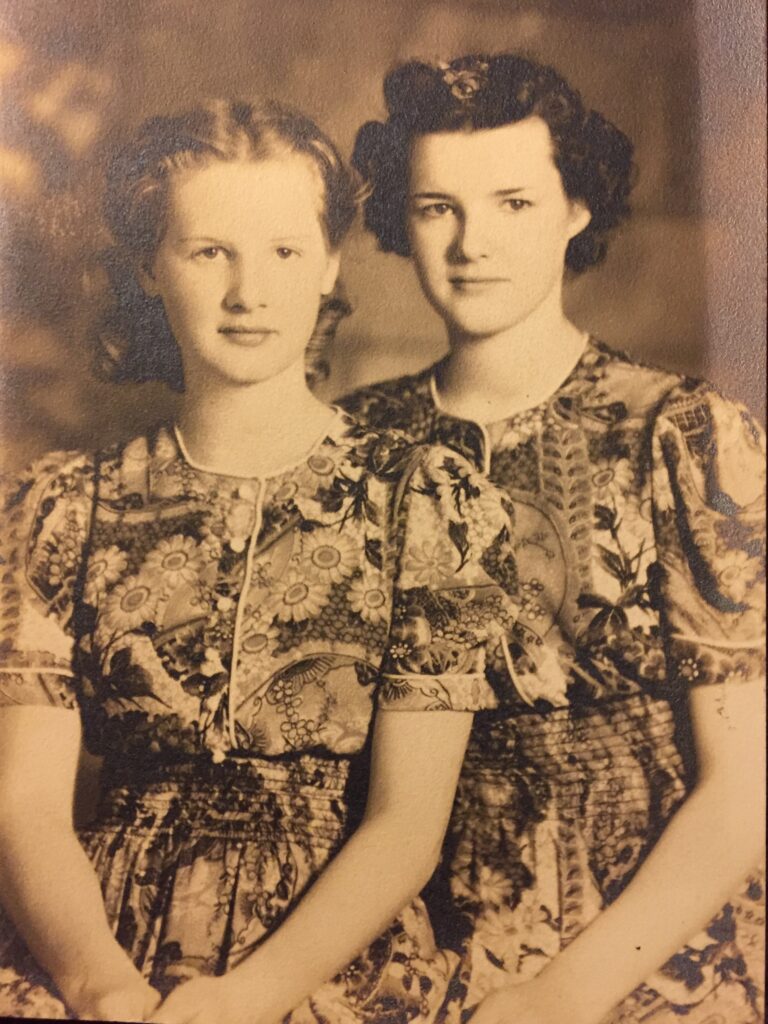
5 September Anacortes – In Anacortes I woke up thinking about Harlem. My grandfather had a nickname in highschool. “Harlem”. Leafing through the 1934 highschool yearbook (Rhododendron – gotta love that name) at the museum in Anacortes, we found Lloyd’s picture. Next to it he had signed “Harlem” with a fountain pen. The ink had faded into a classic old-fashioned range of pale blues.
Lloyd’s parents, Harold and Tressa, had a habit of surveying their son’s homework. Stories tell of them entirely shredding Lloyd’s version of a school assignment and “reworking” it and then making Lloyd hand in their handiwork as his own. Lloyd graduated from highschool early and ended his career as a Rhododendron at the age of sixteen. Family pictures show a teenage Lloyd looking debonair in fancy shoes next to a car on the family lawn. He had quite an allure and he could play several instruments well.
Adam at the Anacortes Museum had been very obliging about looking up Lloyd’s possible musical activities through online access to the Anacortes American (free access up to the year 2000) and, aside from a highschool band photo donated by Aunt R. years ago, found none. There are no records of Lloyd performing anywhere, not even with a google search. I remember clearly hearing him play the piano at home while I was visiting in the summer and aged seven. If he ever played in a band after work or on the weekends, it has never been verified.
“Uncle Lloyd had a big booming laugh,” Cousin K. had said to me when I was visiting her in California. I don’t remember this, but I am happy she has those joyous memories of Grandpa Lloyd.
I got to thinking. A family document states that Lloyd used to hangout at the “colored clubs in Seattle” and this apparently is how he got the nickname “Harlem”. These days the distance between Anacortes and Seattle is about an hour and a half (not taking traffic into consideration).
“He could have gone down with some buddies to play,” I pestered Aunt R. I was thinking Lloyd and the other guys from the highschool band could have possibly commandeered a vehicle.
She wasn’t believing this version of events and I woke up thinking that it was pretty inconceivable.
“How far is Jackson Street from Marion Street?’ I asked the next day.
Lloyd could easily stay at the boarding house on Marion Street run by Cousin Emmy and Great-Uncle Adolf. It wasn’t far to the clubs on Jackson Street, about ten blocks south. “Ah, he must have gone to the clubs with Adolf,” Aunt R. surmised.
I was now sperculating that Grandpa Lloyd could have gone once, maybe twice, with Great-Uncle Adolf and then the name “Harlem” was coined back in Anacortes. Later in 1938 Lloyd attended the University of Washington. He managed to survive two years of higher educational instruction before he dropped out. His dream was to become an architect. His parents didn’t support that dream. Or, here’s a thought, he could have been down at the clubs on Jackson Street and they yanked the college funds and pulled him out of Marion Street and back to Anacortes where he started to work in a chemist’s store.
Throwing in an actual fact, though, sometime before joining the navy in 1941, we do know that Lloyd was up in Alaska on the fishing runs along with his cousin Henry who, at the time, was living with Harold and Tressa. We are also certain that Lloyd saved Henry’s life when Henry’s boat caught on fire.
“It’s a big house,” I said to Aunt R. as we walked around the block and checked out the old house up at the top of 12th Street. At the end of the 1940’s Harold (Harald) and Tressa sold the house in Anacortes and moved to Tacoma. A brand new home was built for them on A Street (Lloyd’s one and only architectural feat). By this time Harold was in ill health and he couldn’t work at sea anymore. Floyd, their second son, was on the verge of dying from a genetic disease that caused him to grow into a giant. In 1946 Lloyd was living with his Hannah in Tacoma. He had a decent job but he was also suffering post traumatic stress from his service in the navy during WWII and was no longer taking work that was out on a boat. All these factors ended the Hansen chapter in Anacortes.
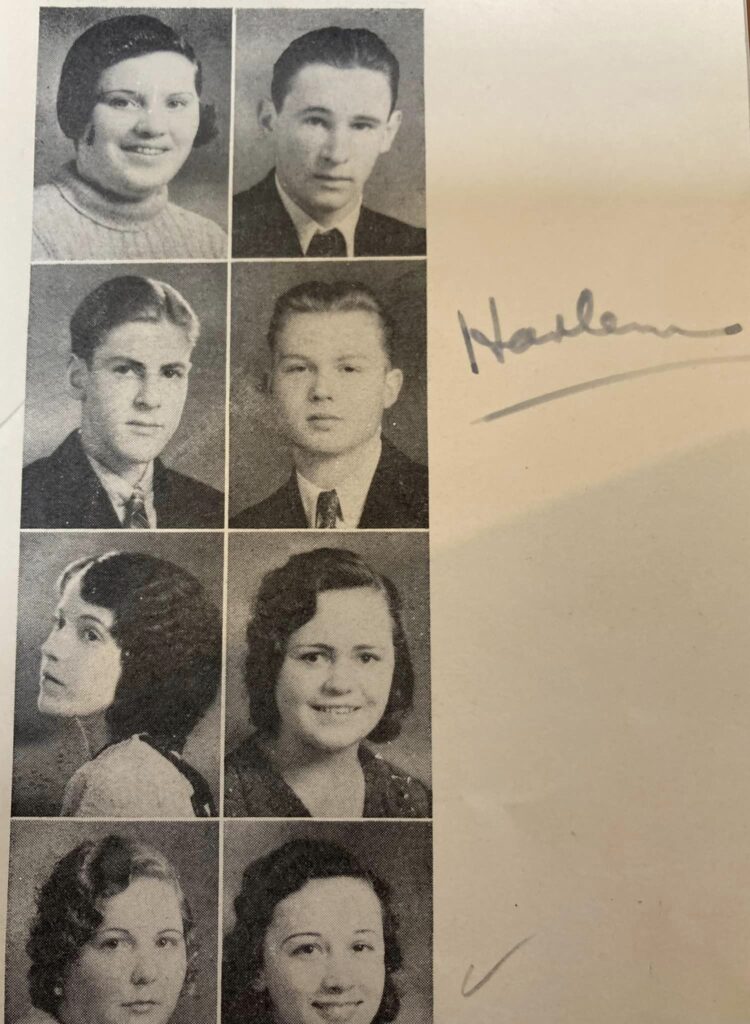
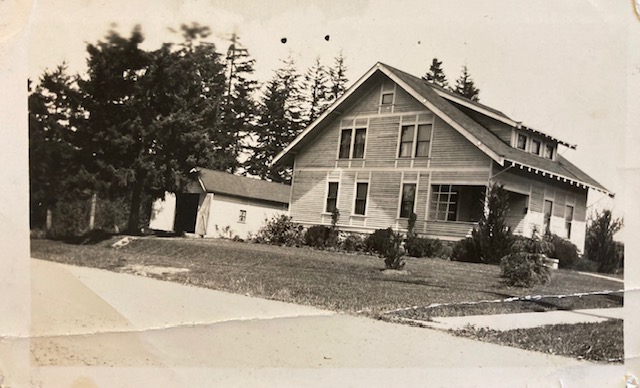
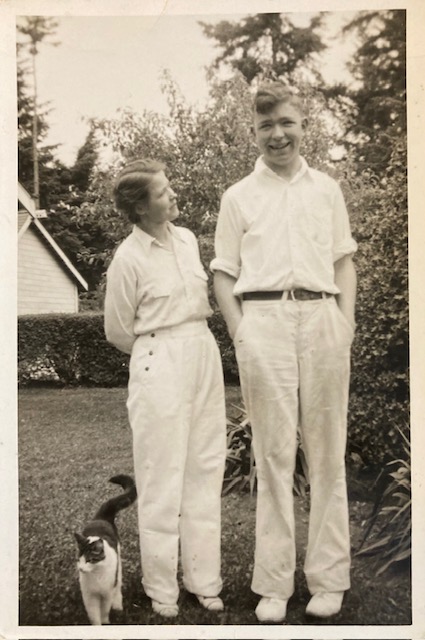
5 September Anacortes – “Let’s hit the casino!” I jokingly suggested on our way out to Black Rock, the seafood store just outside Anacortes.
“I’ll drop you off,” Aunt R. said dryly.
Back in 2021, when the pandemic was still on, I had been forced to stop at casinos on my way up from Seattle to Bellingham and then back down via Anacortes where I had stayed one windy night. At the time there were no other public restrooms available. I’d park the rental car and pull out my passport and then use the toilet and get right back in my car. I am not a gambler and I have a small bladder. What fascinates me is that other people think that they’re owed cash from the universe. Walking into the casinos and threading my way towards the restrooms I would think, “Who are these people?”
In the morning Aunt R. and I had watched people fishing under Deception Pass. They were catching coho salmon. “Silvers,” the man at the seafood store said. Maybe it’s a bit of a gamble but the odds were certainly better in front of the river than the slot machine; those standing on the shore fishing or circling the waters in a boat would likely bring something back home for dinner.
Before the trip out to the seafood store, we ate lunch at Bob’s Chowder. I ordered the Samish Crab Chowder. It was excellent. Thereafter we had decided to cruise for ice-cream. We got waylaid at the Maritime Museum, but first we stuck our heads in the old train depot. In the late 19th century Anacortes had been considered the ideal spot for the terminus of the transcontinental railroad. “The last train was in oh, about 1980. Even then it didn’t come often.”
The notion that the train travel would end in Anacortes was, in fact, correct. And the notion of the intercontinental terminus went entirely bust quite soon after the railroad’s grandiose announcement, ending speculation and immediately causing a significant real estate slump in Anacortes. And this was well before the turn of the century.
“I’ll have the peach ice cream and the huckleberry ice cream,” I said when we finally set foot into a store that was selling ice-cream. The one across the street from the train depot was already “closed for the season”. And it’s only the beginning of September. Yes, I do worry about the word “season” not lining up with the temporary closure of the ice-cream store.
There are pictures of Grandma Hannah standing in front of the McDugle-Wagner Creamery where she worked serving ice-cream as a teenager. ‘What was her favorite flavor?’ I asked Aunt R.
“Strawberry.”
“Pink.”
“Yes.”
Pink was Hannah’s favorite color.
Aunt R. used to walk down to the McDugle-Wagner ice-cream store on Commercial Avenue when she stayed with Great-Aunt Margie who was married to a McDugle. Margie’s husband was the man behind the wheel of the company’s delivery truck. The pasture and family farm was up in nearby Summit. In town, Margie’s kids and cousins were served free ice-cream. Aunt R. remembered the house she stayed at on R Avenue, the daily walk to the creamery business buildings and the location of a house of a friend with whom she would hang out during the summers and avoid her cousins. Just being a kid.

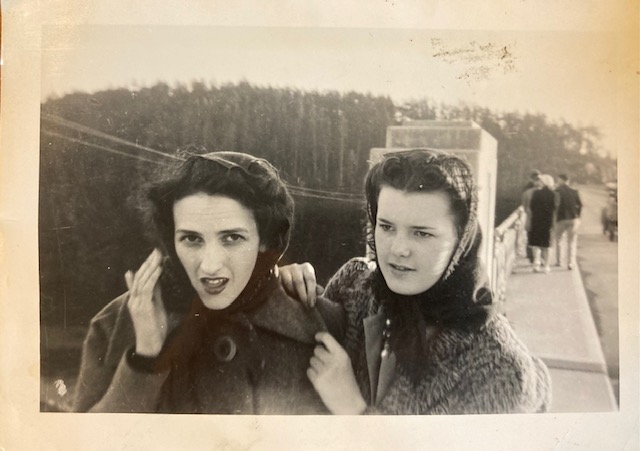
4 September Anacortes – “It was primitive. Aunt Margie had a cabin and we would go for a night or two to the island.” I looked up Hope Island. It is now a Marine State Park and has been since 1990. As a child, Aunt R. visited Great-Aunt Margie during the summer in the 1950’s. Before the state took over, Sarah Munn was the last proprietor of the island, having bought it with her husband in 1943. But to my aunt’s recollection there were quite a few cabins on the island, all without running water. “Someone had built a bathroom onto one, but we had to pour a bucket of water down the toilet to flush it.” The taps in the sink weren’t ever connected to water. And there was no dearth of family members, everyone piled in the cabin.
“What happened to Cousin Brn?” I was looking online at the string of Great-Aunt Margie’s descendents. “He died on his own birthday.” Cousin Brn was what one might say an “optimistic” person because of a lack of forward thinking.
I met him last when Step-Grandpa Art (Hannah’s second husband) took me up to see Great-Aunt Margie. ‘We are not going to stay long,” Grandpa Art reiterated on the drive up to Anacortes. I was driving the big black van and we had to stop off at Denny’s to pick up a pie that was mostly Cool Whip. Can’t arrive empty handed. Great-Aunt Margie was wearing a pink sweatsuit ensemble and looking, as usual, larger than life and, paradoxically, in extreme poor health. Cousin Brn (and his wife) was living with his mother and there wasn’t more to say in polite company about Cousin Brn Or his wife.
Reviewing the dates of his demise, images began to float through my head of Cousin Brn deciding to do something spectacular for his birthday like blowing himself up with an apres 4th of July box of fireworks, a display gone awry, or performing that last celebratory wheelie on a steep hill along a curvy road up the side of a mountain or his electric guitar flared up and electrocuted him after he played the four bars of that Eagles’ tune that he had learned one too many times in a loop. In any case he is buried in the same grave as his mother Margie. There is no obituary online for Cousin Brn. It almost feels as if the family said, “Here he is. Back to you, Margie.”
However, on a very sad note, Cousin Brn’s son R.B. died early as a result of an overdose and the family was quite loving and frank about this matter in the obituary. And this brings the story of R.B.’s father back to the fore. It could have “just” been drugs.
Aunt R. and I strolled down the hill towards the Anacortes Museum. We had a few questions to ask and the museum, a former Carnegie Library, was open. A very nice person named Adam helped us. He pulled out directories to double check addresses. It was fascinating how a boom town helped Great-Grandpa Pete Ratzlaff rise from a renter to an owner of a house and was able to support five kids because of employment in the pulp mills. And Great-Grandpa Harald (Harold) built a house on the hill, away from the sulfur smell of the pulp mills, that overlooked the fish canneries where he was employed.
“You mean John Ratzlaff?” Adam asked, having opened up a directory. He was checking the r’s.
I had no idea the two Ratzlaff brothers, Pete and John, had both settled in Anacortes. No doubt it had been an opportunity for families to thrive. These days there is no one left in the city that either Aunt R or I would recognize. We wandered down Commercial Ave for lunch. Because of the extinction of the canneries and pulp mills, Anacortes has, so far, bypassed overdevelopment. It’s a charming place to spend time in.
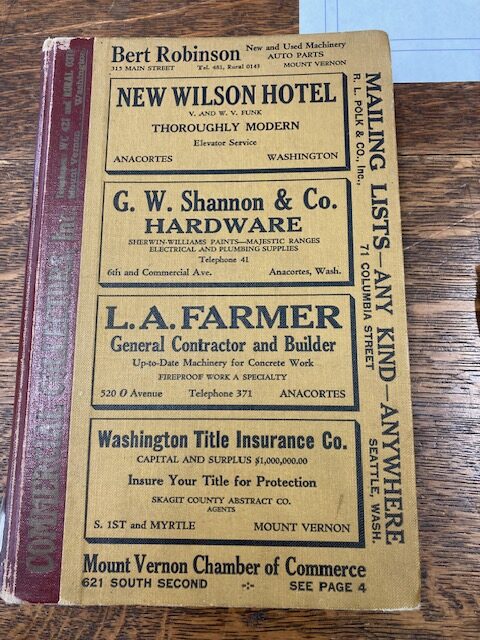
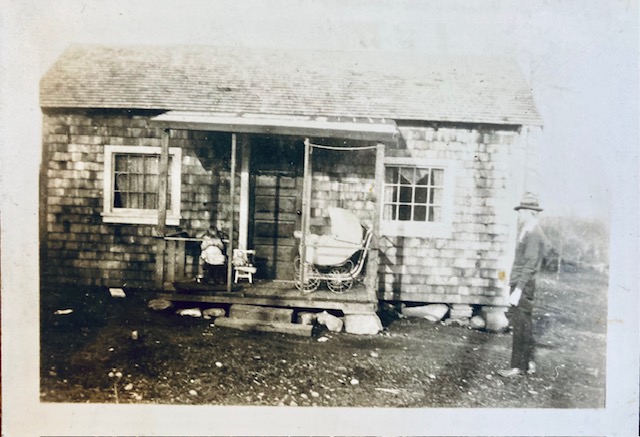
2 City Precinct
2 September Seattle – “You put your paddle in and row with the others,” is what people say. But for so many years my family just fell apart. And in the case of my mother’s side of the family – it had been coming apart at the seams long before my mother cut contact with my grandmother Hannah, an act which was felt within the Abbott side of my family as well.
Now at the end of the first section of my trip to the states, I know I have been lucky this year. Family members invited me into their homes, their hearts, and into engaging discussions. I had the opportunities to see the sights of my childhood vacations in Tacoma, such as my grandmother’s house. It’s been a time of connection and activities. I feel back in the fold.
And nothing of the past is what one would say “solved”. Nothing will ever be solved. What happened is far from a compact Hallmark movie or Made for CBS Special. It’s horribly complicated and tragic and involves deception and lies and manipulation and worry and concern. The drama that encompassed my being there and not being there impacted so many of my family members’ lives. And people got on with their jobs, their families and their communities because that’s what we all do to survive.
I still have questions and most of them to myself. If I roll back the years my life up to 30 year of age boils down to this:
1997: Reconnect to Hannah
1996: Out of survival mode, onset treatment of depression
1995: A stable living environment with partner and income
1994: A work permit after six years of living under the wire in Europe
1988 Move to Europe with no intention on returning
1985 Attend college in Ohio, leave without graduating
1982 Last letter from Hannah, my mother ends that relationship
1980 Last trip to WA to see my grandmothers
It’s the beginning of the sequence that I still question the most, the years between 1980 and 1983. What happened there? I have journals that I wrote, I’ve been looking at them from time to time and it takes courage to go find myself, brainwashed and gaslighted and a teenager and trying to make the best of my situation without challenging anyone directly, because I now understand some of the scope of the hell, the fallout, that family members experienced. I also have the letters I wrote my parents over the course of twenty years, and in which I tailored my information to elicit their approval. So far I haven’t been brave enough to go read those letters.
There have been moments when I have asked myself why I didn’t scream and smash all the effing pieces of art in my parents’ house to smitherines, those all important totems called art or those more important than people items that were supposed to represent a higher culture, and tell them to go jump in a lake. I never did that, but after Hannah died I walked out of their lives because I couldn’t take who I had to be for them anymore.
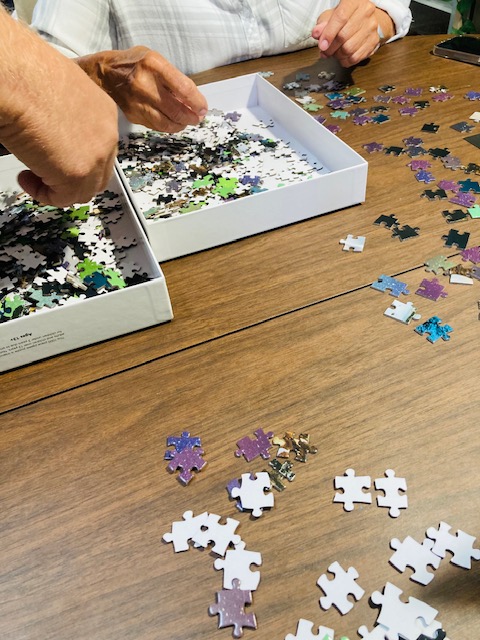
1 September Seattle – Basically, if you want to look at it this way, what I “inherited” from my father was a couple of dead beat publishers and a pipe dream. I wasn’t planning on inviting this particular trio into my life, but since I opted for chasing down the IP, I figured I might as well continue where Keith left off. I get the impression, however, that he wandered away, heading down a different path to go think about something else than Not Being Paid Royalties and not ever signing That Big Contract.
While on Vancouver Island I was reading info online at Ancestry.com along with Cousin Becky who enjoys genealogy. “I noticed,” she confirmed. We had just addressed the fact that my mother had taken two separate DNA tests for Ancestry. I started to explain a particular feature of that duo endeavor, as a result of one of those spit tests, and my cousin’s mouth fell open. Her reaction brought home what kind of lunacy I had been wading through most of my life.
Cousin Becky brought out an envelope my mother sent her in 2003. I read the note. “Why did she ask you for Great-Aunt Mary’s address?” I asked. To be clear: we are talking about my mother, a woman who alternately shunned, stalked and, in the end, verbally attacked and slandered her family members. My brain started whirling. I wanted my brain to stop whirling. I began to worry about Great Aunt Mary and I suspected that whatever this request had been about, the whole purpose was probably unpleasant. Both Great Aunt Mary and my grandmother Hannah (still alive in 2003) are now long dead. I should really stop worrying about these things.
I do try to focus on the positive, such as my father’s talent and his work. It’s the best of what’s left. Well, what’s left of it. Question: What happened to the missing materials? Finding Keith’s calligraphy by chance in the charity shop this week pretty much blew my mind.
In the package of materials he sent me, Tim Hildebrand included his book Rotwang (1976, Blue Wind Press). I read the first twenty pages before I left for Vancouver Island and recommended it to my Cousin M. (where I am staying) who is a fan of the psychedelic world. I thought Tim’s book was very funny. When I returned to Seattle I finished reading the publication, a trippy sequence of what I think would be the continuation of the fascination with 20th century progress and Getting To The Good Life the American Way via The New Frontier of Space. Frankly, I have no illusions about this but I would like to retire early on earth. The possible assistance of three Aliens named John, John and John had never occurred to me. In my case, I made an excel sheet which proved indecisive. Allow me to turn my attention back to the Not Being Paid Royalties and not signing That Big Contract, aka the pipe dream.
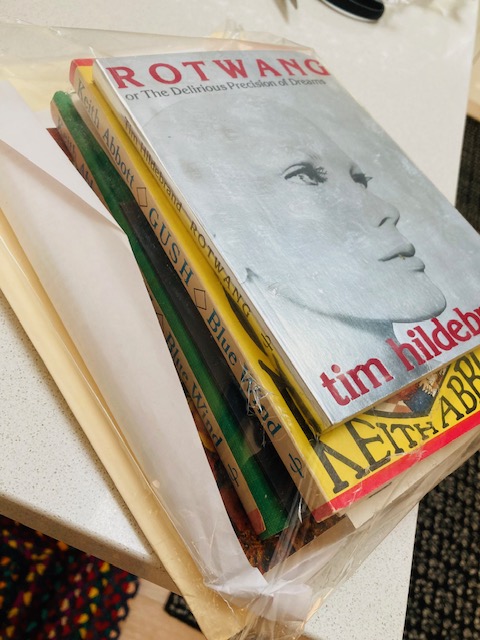
31 August Seattle – After an appointment in Edmonds last week and finding time to spare, I headed to the Goodwill on my way out of town to look, of course, at the used books. Parking, I noticed a charity shop next to the Goodwill.
The new proof copy of Mordecai of Monterey was expected to be delivered today. I was crossing my fingers that the revised format would be an improvement on the first proof copy. But I had to leave the house before the mail arrived.
Back in Edmonds and arriving early for the first of the two appointments today, I decided to swing by the charity shop again. It had been on my mind since I woke up. What could there be in the shop a week later that would draw my attention? I didn’t think much.
At the charity shop, I shuffled through the artwork. Quite a selection of additional prints had been put out in the bin. And then I froze. I was looking at my father’s calligraphy. The piece wasn’t signed, but it is his. I’m taking it as a loving sign from above and when I returned to the house I inspected the new proof copy of Mordecai of Monterey. It’s ready to roll.
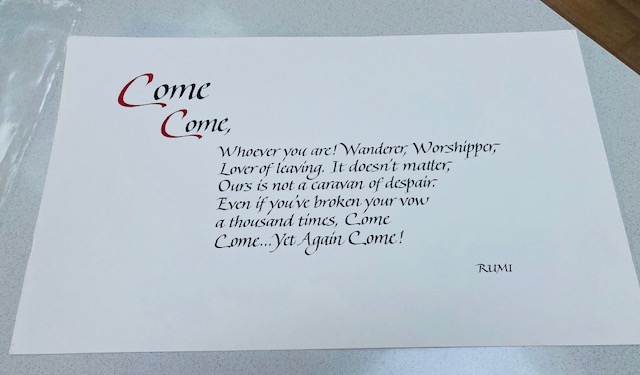
30 August Seattle –
“While I am at the Prado enjoying Goya and Velazquez
My father is rising before the sun
To assemble filters.”
Erika L Sanchez, from “Lessons on Expulsion”
Reading these words, I weigh the thought that you don’t really have to be rich to stand in the Prado. You just have to be there. I left for Europe at twenty-one with a suitcase. I was in the middle of a nervous breakdown, but I was unaware of this matter because no one had bothered to tell me. I was hired as an au pair in Paris which is how I managed to justify leaving the USA. The family I worked for rented a room for me at a Catholic pension pour jeunes filles. The place was run by nuns and I had a room to myself. I got up early in the morning and worked until 8:30. Thereafter I was free for the day. That is until around three thirty when I had to return for a few hours to the apartment to help with after school activities. Upon leaving my morning shift I would stop by the bakery for a mid morning treat and most times I bought the Herald Tribune. Then I went back to my room and read the paper and slept until two, whereupon I would eat the packed lunch that I prepared at the family’s apartment. And go back to work. After work I returned to the pension pour jeunes filles where I was served a dinner. Leaving the table, I immediately climbed the stairs to my room on the top floor of the street side of the building and went back to sleep.
“Are you enjoying yourself going out with the other girls?” Madame asked me one day.
I said, “Yes.” It was the easiest answer.
This routine lasted about two months. After that I began to feel better.
I went to every museum listed in the Pariscope, checking them off with satisfaction.
The Pariscope is no longer in circulation.
In Washington state there are blackberry vines just about everywhere. There never will not be blackberry bramble at hand. Mythical bramble that swallow cars and houses and hide black bears. At this time of year I can smell their ripeness in the air as I walk past. I stop to pick a few for a snack. No one has to work to eat blackberries, they are free.
My father didn’t have to assemble filters for a living. He hauled trash, trimmed trees and scouted books for a bookstore. His own father once criticized him for not getting a “real” job and buckling down to support his family. I sometimes think my father thought he was living just like a blackberry patch. Free.
Along came that Zen notion, cruising by in a deSoto. Was my father’s entry into the Zen Club a new type freedom once the blackberry patch had been razed? Around this time I was living in Singapore and my father had a sabbatical from his teaching position at Naropa. I invited my parents to visit Asia. They never came. I still don’t know what to make of that. Was it because of Singapore’s drug policies that my father wouldn’t set foot in the country because he was still a daily user? Was it because I was living in a black and white colonial bungalow in Asia that caused jealousy and conflict?
Wandering around the Japanese Garden, part of the University Arboretum, with family members recently, I thought maybe I would feel the spirit of my father. Sometimes I do and I am waiting for the latest proof copy of Mordecai of Monterey to arrive in the post. I just felt blank. Perhaps that was The Thing. In any case, it was freely distributed.

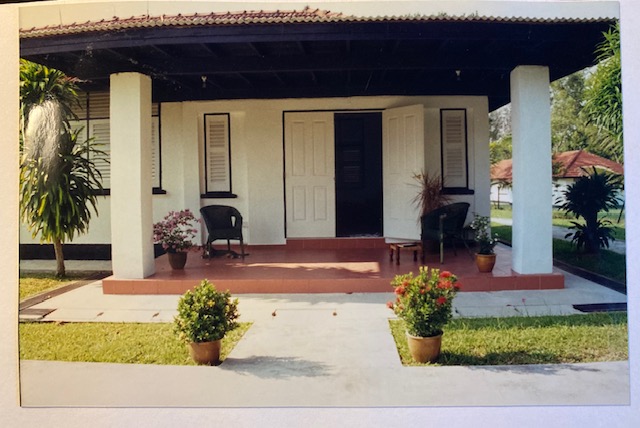
28 August Nanaimo – “She took me to church,” Cousin Becky said to me. Well, not surprising considering Kae’s convictions. As a teenager Cousin Becky had been deposited at Kae’s house over the weekend. And given the circumstances I might easily be convinced that one (mandatory ecclesiastical instruction) plus one (visiting granddaughter) equaled a serious bout of religion. “They were speaking in tongues.”
Ah, that kind of Church of the Nazarene. I had no idea that this was part of my great-grandmother’s worship routine. I had been once to a church in Ohio where people spoke in tongues as part of what the college curriculum used to entitle an “ethnomusicology” course. At the time I had considered approaching a church congregation that handled snakes for my assignment but then someone crossed my path who represented the speaking in tongues tradition so I went along with that opportunity. I doubt my great-grandmother would have been happy to handle snakes while in a pew, but then again I sense that she liked the wild side a tad bit more than most staid Mennonites.
“Uncle Grandpa Henry wouldn’t let her cook on Sundays. She had to prepare everything on Saturday.” More information from Cousin Becky. I recalled my grandmother Hannah writing in one of her letters about how Kae and Henry (Kae’s second husband and the brother of her first) were quarreling in the car during a long drive in an emergency situation. “But she pretty much did whatever she wanted.” That sounds about right.
Looking at Jimi Hendrix’s orange stage suit standing stock still in the Seattle MoPop and I thought about the trousers my father wore in the late sixties and early seventies. I examined the photo of Hendrix and his turquoise bracelet and it seems not to mean much, all that turquoise, except it’s part of the psychedelic trade of the era. In the cases lay the snippets of lyrics and stubs and I wondered where my father’s lost archives are kept.
“If you ask me, she buried it deep,” my father’s sister said to me, referring to my mother’s Machivelian scheming.
I paused for thought. It took me two and a half years to dislodge the IP. (I learned a thing or two along the way in the house I grew up in, including my mother literally teaching me on how to persist along with a demonstration of tactics and I for one certainly don’t relish these actions). During the IP battle I bought a few domain names. But then the end came swiftly, despite me thinking that my opponent was about two months behind my calculated schedule of “them finally caving in”. I never used the domain names but I still own one.
“Keith wanted a pair of corduroy trousers that weren’t the usual color,” my aunt said to me. Grandma Gert had to explain to her husband that kids “these days” followed trends that didn’t include brown or green corduroy trousers and that was ok. Hearing Gert’s words, her husband gave a grunt, but he did stop complaining about the color of Keith’s corderoy pants. My father told a story about wet corduroy trousers as a result of jumping into ditches as a kid. What did they use to say about Grandma Gert? “Bar the doors, Katy.” She could hold on to a notion and drive it hard.
Trust me, strong women aren’t a pain in the behind, they are a blessing. Women like Kae and Gert are the glue in their families in their own unique ways and I am proud to be part of the club.
“I need to go back,” Cousin Becky said to me, referring to the chinaware she had seen in the thrift shop we had visited. She had sent a photo to her daughter. “She wants to use the pattern for a tattoo.”
“Well, you won’t need a china cabinet for all those tattoos,” I thought, having examined Cousin Becky’s display cases which reminded me of my grandmother Hannah’s house. I happen to have a few of Hannah’s china cups and saucers. I also like the patterns. (Photo of Kae Ratzlaff)
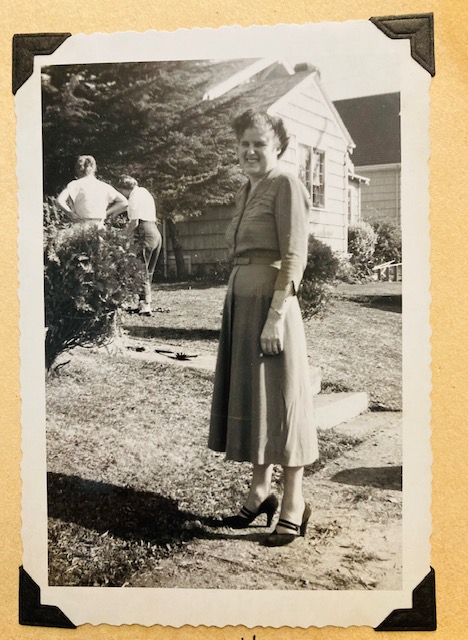
Augusr 26 Seattle – Victoria – “Breakfast,” the man said, bustling over after being hailed by the passenger behind me on the Clipper sailing from Seattle to Victoria. The passenger requested a recommendation. “I would suggest Frankie’s. Eggs Benedict and Bloody Marys.”
We had just seen a pod of orcas. The boat had slowed to a stop out of precaution.
“They were all drinking beer as she was dying,” my aunt said to me about her niece in Canada. “I didn’t stay afterwards.” Cousin T. had had a hard life, by all accounts. My father never talked about his “wayward” niece or “troubled or troublesome” nephews, the children of his eldest brother. My father would roll his eyes and then fall silent. His brother’s first marriage had been to a woman with unstable mental health and who had done “quite a number” on the kids.
“I managed to make it in time,” my aunt said, recalling trying to cross the border after getting a call. She almost didn’t, a bridge had closed. Despite the best efforts of family members, she wasn’t able to get a seat on a small plane to fly out of the nearest airfield. She had to turn back and try again the next day.
I wandered around Marshall’s. Not that I needed to buy anything, I was headed into the store for entertainment purposes. I looked at soup bowls with rough applique motifs that came with microwave covers. I imagined that my grandmother Hannah would have probably stopped and said, “Oh!” at the sight of a self contained soup bowl. I examined tea towels with Halloween themes. I enjoyed looking at them. There had been a time in my life that I would have felt guilty, had I stopped to admire a Halloween themed tea towel.
The seasons, the holidays, the celebrations that pertained to the family had generally been ignored by my mother, or more likely belittled. Instead the Dalai Lama, in orange no less, and the Spider Woman (Navajo, not Marvel) were given merit, aka spooky reality. I couldn’t really believe that the Spider Woman was given credibility to wield a magic wand about over a load of anglos and Thanksgiving dinner was boiled down to the nightmare of the three of us in one house made to eat a resentfully cooked turkey because there was no escape from the dreadful episode of the vetted holiday cheer until the clock struck midnight. But that Spider Woman, hey now there seemingly was something to ring bells for and a much better idea than any sliced bread on the market.
“I told her that being Native American didn’t make anyone better than not being Native American,” explained one of my mother’s down-to-earth acquaintances to me, after my mother’s death. “And I knew she wasn’t Jewish. I saw her Ancestry.com results.” It took me months of wrangling with the ethics commission overseeing the synagogue to get them to admit my mother had misrepresented her roots.
Cousin T. had been thrown out of her home at thirteen by her mother, had survived the streets, had exited an abusive relationship, had dealt with deadbeat kids and had finally found a good husband and some essence of calm. Then her health had failed her, she tragically died relatively young after a battle with cancer.
“Better put in a bank of drawers,” the woman behind me on the Clipper said into her phone. We were about halfway to Victoria and she was talking about home renovation.
I wasn’t necessarily rebellious as a teenager. I was always looking for the right way of doing things but, as an autistic person, I was constantly rewiring all that I witnessed. I then wedged it into some aspect of conformity, set to some silent list of rules. Like it was not seemly to admire Halloween tea towels because anyone who did was “insipid” and “uneducated” (the kinds of words that I heard to describe people who liked Halloween tea towels) and the hell with Spider Woman (that was my take and would match with the first item on this list). And that was a rule.
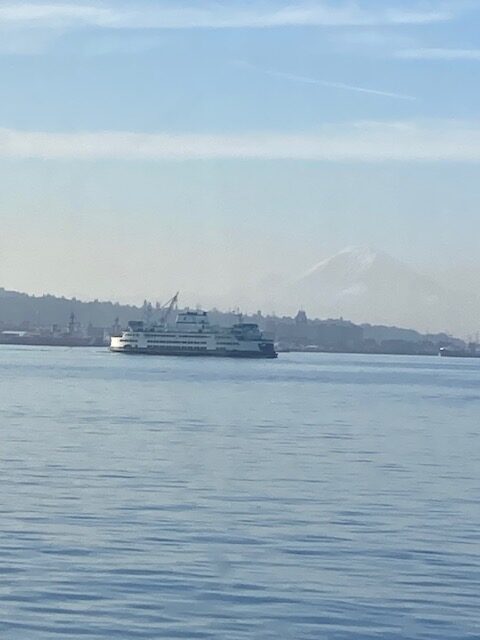
25 August Seattle – I met J. at the beach. We stood on the rocky shore. The train tracks lay behind us. We watched the freight trains roll along the waterfront. In a way she and I have quite a few things in common. Alienation from family members and removal from cultural heritage, for example. Except you might say we were on opposite sides, as if we had been pitted against each other.
“I met your mother,” J. said. She had been involved in an American Sami association in the Northwest and she is an American with Sami ancestry. My mother had claimed to be Sami through her grandfather. A claim that is not correct, my great-grandfather’s family in Norway do not identify as Sami. Perhaps, this is a basic finger in the wind estimate, one person in forty/fifty/hundred in the family could have had a connection to the Sami and the Sami traditions never took hold on the island in the arctic circle where my great-grandfather was born.
In the end we are all people. “Who are your people?” It’s a basic question. And it’s not about having funds to make a donation to a prestigious institution or cornering a patch of academic glory by using a real or invented association to the Sami world to be called an “expert”. Dare I say, gatekeeper.
I believe that there is now a consensus among the people my mother met over the course of her lifetime: she was mentally ill. She created division by sowing seeds of hate and fear. I don’t know if she loved herself. I do know that her family and her friends loved her. Whether that was reciprocated well, somewhat, maybe, occasionally, genuinely or perversely is up to the individual.
Belonging to your own family should not be a political game, and yet there could be political games afoot. “So,” my cousin’s wife of Norwegian descent in Seattle said to me about her family living in Alaska, “my daughter had to pay all the bills for having a baby.” And another family member, also in Alaska and a family member by marriage and (part) Aleut, had not been presented with an invoice because of the tribal health care policies.
J. was raised in a strict Christian community with strong ties to the Sami across Scandinavia. Upon leaving the religious organization she was raised in and their beliefs, she had been ostracized. Eventually she started researching her roots and reconnecting with family members in Scandinavia.
Basically, it could be said that J. and I both had been penalized by our own immediate family members for reconnecting to extended family and traditions.
My mother traveled around the states and hobnobbed with various Sami American groups, peddling her false narratives and apparently she wasn’t the only one active in misrepresentation. J. started asking questions in her own Sami American community for specifics about how and where members were linked to Sami heritage. She discovered the hard way that this was not “cool”.
“I contacted him,” I said of a professor of Sami studies at the University of Puget Sound. I had reached out to him after I read his review of the book on Sami Americans for which my mother gave an interview.
“He’s an apologist,” J. said. “Good luck with that.”
She meant he probably wouldn’t meet with me, even though it was his suggestion in his reply to me. Thereafter I had answered I would be in Tacoma on such and such a date and heard nothing back. In his initial email to me the professor stated that he wouldn’t be able to tell me if my family was Sami or not. I think he missed the point. I wasn’t asking about my family heritage because I know my family heritage. My point in meeting was to discuss this misrepresentation that my mother was able to flog for years on years and a community that had not, it seems to me, asked valid questions. “Who are your people?” My mother appeared on the horizon like a lone wolf, howling about victimization.
That book is still for sale.
“She was very upset,” J. said to me about another interviewee in the book. “She felt that she was misrepresented in the write up.”
It was when I posted a little piece about my feeling regarding the Buffy Saint-Marie story that broke in the fall of 2023 that J. reached out to me. I’m glad she did. To me our meeting had a tinge of “truth and reconciliation” to it. There’s no point in continuing the undermining tactics of division, misrepresentation, exploitation and suppression. Why not opt for a dialogue?
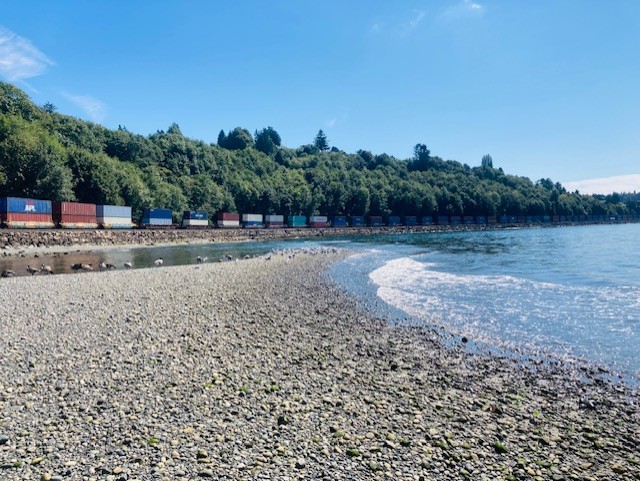
26 August Seattle –
August 23 Seattle – “There’s just that mean streak running around the family.” My second cousin meant a trait in the family, and he was referring to what we shared in common via DNA: an abusive parent. His father had been mean, and his father’s grandfather, a man named Johan Adolfsen Eckstrom, had been mean. Many of Johan’s kids fled their family home and headed west once they got old enough. Thereafter Johan (or John) trailed them from the Wisconsin farm (he sold the farm after fifteen years of farming in the Midwest), arriving in Seattle to do something else. He wasn’t noted to be successful, he just was. And he was taken in or looked after, from time to time, by a family member until he died. His daughter Marie had been his terminus. Of all places, he died in Los Angeles which in a way is perhaps fitting.
Great Aunt Marie was once married to Aryan Kelton, perhaps one might call him the “other writer” in the family. She wasn’t married long to Kelton and Kelton was a man with ambitions. Well, in those days in America most people started at the bottom of the ladder, and Kelton was no different in that respect. He also decided to try his hand at something other than farming.
Emmy Rudd, Great Aunt Marie’s cousin, ran a boarding house on Marion Street in Seattle. (From an internet search I see that historically there were quite a few boarding houses on the same street.) At some point in time several of Marie’s siblings were somehow involved in the running of the business. My great-grandmother Tressa was working there as a waitress before she got married in 1916 to Harold (Harald). And Great Uncle Adolf was, not so secretly, romantically linked to Cousin Emmy, who was a fabulous cook. The boarding house was a base and a mode of freedom and self-improvement for the family.
Quite frequently during the 1910’s and through the 1950’s “entertainment and/or intellectual” people on the lecture circuit stayed at the boarding house. This meant that there were discussions at the table about all sorts of “new fangled” ideas, including spirituality, telepathy and even eugenics. I am not sure that anyone in the family really bought into the (distasteful) proposals of eugenics in the early 20th century but the telepathy and spirituality notions definitely lingered on in the family.
“Yeah, Aunt Hannah talked about Mount Shasta and the tunnels once,” my cousin said to me over breakfast, recalling a conversation he had with my grandmother.
In Olso Cousin Bjørn is still tracking down from whence Johan had emerged before he showed up in the valley where his soon-to-be bride lived. He was “foreign”. He was Swedish. That didn’t make it any better. He was for all appearances a lone Swedish fellow who wandered over the border and got married to a Norwegian woman named Petra. Cousin Bjørn indicated to me that Johan’s disagreeable characteristics eventually led to friction in the family, relocation from one valley to another valley and then immigration to America in 1905.
Cousin Bjørn is looking for documentation linking Johan to his father Adolf. Every once in a while he sends me an update on his genealogy findings including possible answers about Johan’s family. And then I am prompted to check Ancestry to see if someone matches my DNA in a way that might be traced to Johan and his mysterious origins.
As for my Great-Uncle Adolf, named after his “non-existant” grandfather, he wasn’t like his father Johan. Adolf was able to sustain himself well enough and be supportive and beneficial as a family member. He liked books. He had quite a collection and it is because of this that I have read an opus of Aryan Kelton.
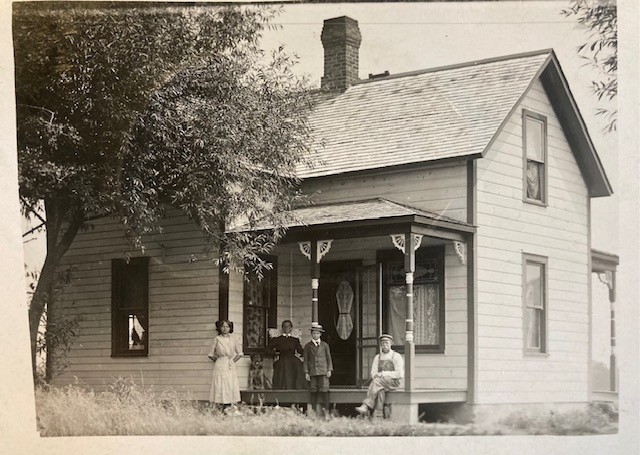
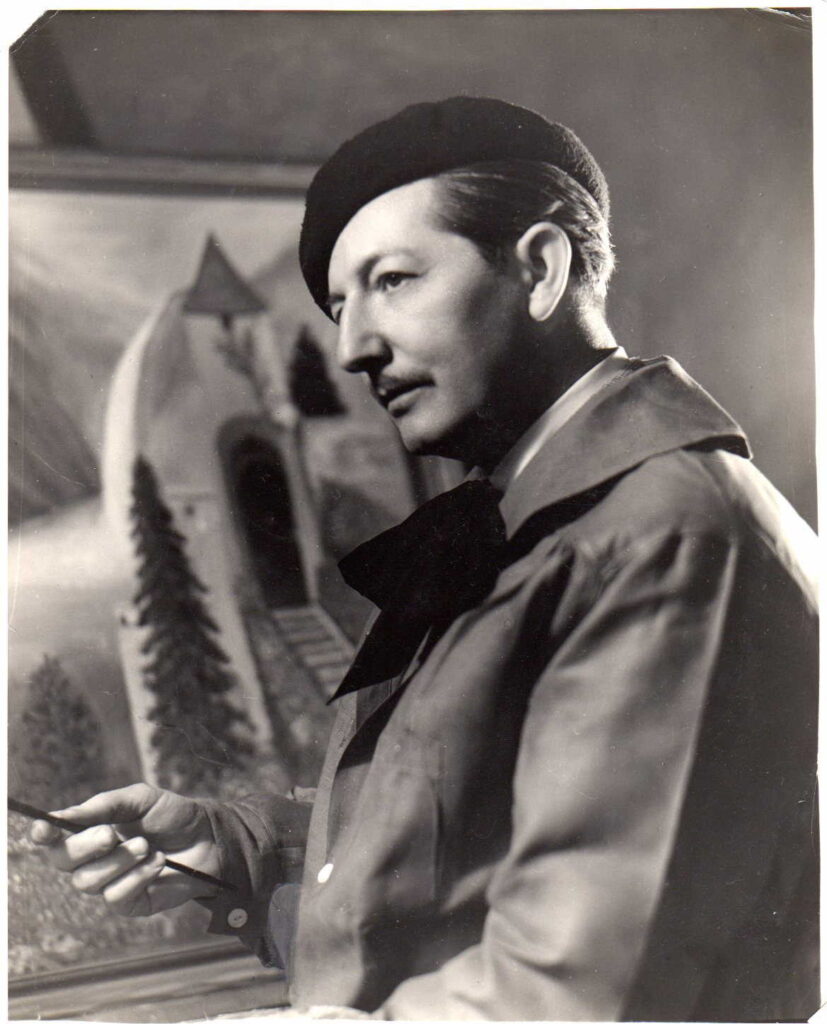

August 22 Seattle – “I have some materials of your father’s.” The message came several months ago. I notified the sender just before I left for the states that I was on my way. The package came in the mail to my cousin’s address in Seattle. It included copies of Keith’s published books. Gush, Rhino Ritz, Erase Words and What You Know With No Name For It. “You ought to re-release Gush,” my father’s friend Pat Nolan said to me. I am thinking about it. In August Mordecai of Monterey will be released.
And in the package Tim Hildebrand kindly included a copy of his own book Rotwang. On the back was a photo of Tim. While I had recognized his name when my father’s friend first wrote to me, I was finally able to put the name to a face.
Tim also sent photos of Keith that he had taken in the 1970’s. Some of which I had never seen before, photos that had been shot for publicity purposes for Blue Wind Press. I greatly appreciated receiving the photos and the books.
There are few photos of Keith at “home” where I grew up in because a camera was not allowed in the house. I will just leave that statement for what it is. It’s a pity that, while I have some pictures of my father when he was visiting his family in WA, there are hardly any of him with his friends such as Richard Brautigan, Pat Nolan, Philip Whalen, Tom McGuane etc.
Photo: Keith Kumasen Abbott in front of the house on Sutter Street in Berkeley with his Chevy truck and chainsaw. Note: I have taken photo of the negative sheet. The original photo was taken by Tim Hildebrand. This image does not adequately reflect the quality of Tim’s original photo.
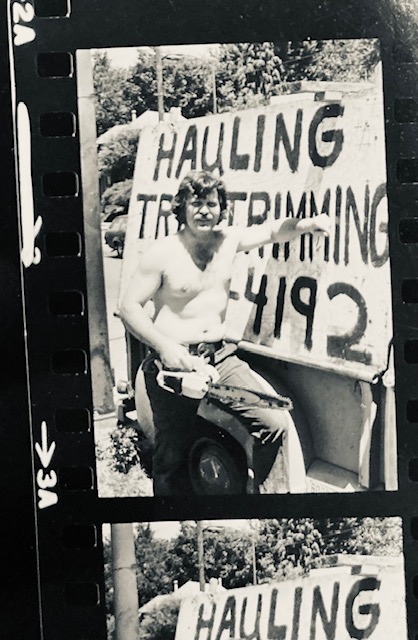
August 22 Edmonds – Every once in a while I stop what I am doing and lift up my head to listen to the sound of a passing train. The low, plaintive horn of the trains can be heard around the Puget Sound. My father used to bring me up to Tacoma on Amtrak which was a highlight of my childhood. At Union Station Grandma Hannah would pick me up. Keith relinquished me to his mother-in-law (who would swap days with Grandma Gert) and disappeared.
“He used to go see his high school buddies,” Aunt Judy said.
I had never heard of this. “Who?” I asked, thinking of the characters in my father’s book ‘First Thing Coming”. Exactly who were Hubie and Flipper and Ripolla and Dougie in real life? In his books Pete was my father. That much I knew for sure.
My aunt pulled out her high school yearbook when she had been a senior and my father a freshman. She started to look at the photos. She pointed out some names I had never noted.
For my own part, I had contacted a childhood friend who used to live across the street from Grandma Gert. My friend and I had corresponded for many years until sometime between entering college and exiting college and me leaving for Europe, we lost touch. Forty odd years from the last time we saw each other, we met again and visited the Cascadia Museum in Edmonds together. It was a delightful place to be and the collection was splendid.
Looking at the pictures I thought about my Grandma Gert who enjoyed painting oil paintings. She was an amateur artist and one summer she gave me a paint by numbers kit. I don’t recall that I showed much promise.
The exhibit my friend and I viewed was A Legacy Rediscovered: Northwest Women Artists. I stood in front of a Doris Totten Chase painting (Untitled, 1956) which showed a woman ironing in a yellow and gray decor. The loneliness of the painting somehow reminded me of Grandma Gert’s stories about having nothing to do during the first months of her marriage to my grandfather. She had quit her accounting job to get married in 1930, as one did, and then found herself in a small cabin with ferns growing up through the floor. She did not relish those memories.
I rather enjoyed Dorothy Milne Rising’s “Mountain Mood” and was equally delighted by Jane Baldwin’s “Fourth Street.” I gazed at Tacoma artist Beulah Hyde’s painting of a factory and wondered if Grandma Gert ever consulted with her about painting. I never knew of these communities of artists or that women artists existed in Tacoma. The museum is planning a retrospective of Hyde’s work in 2025.
“Did anyone else write about the 1960’s in Tacoma like Keith did?” I asked my aunt.
“No, I don’t think so,” came the reply.
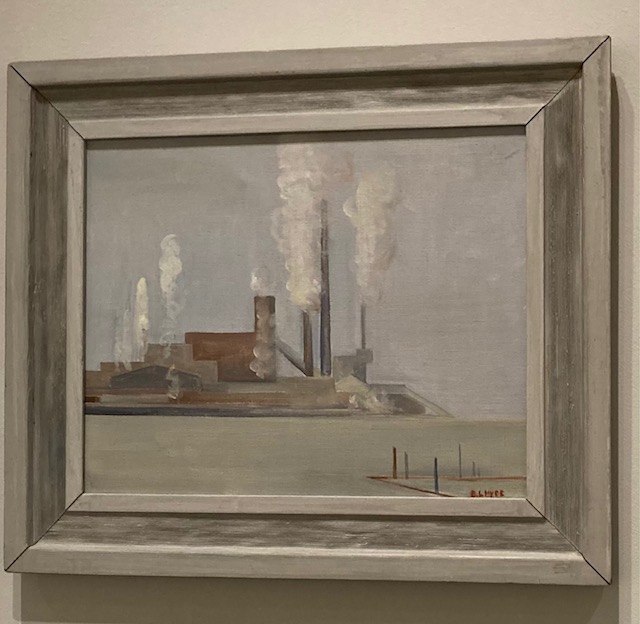
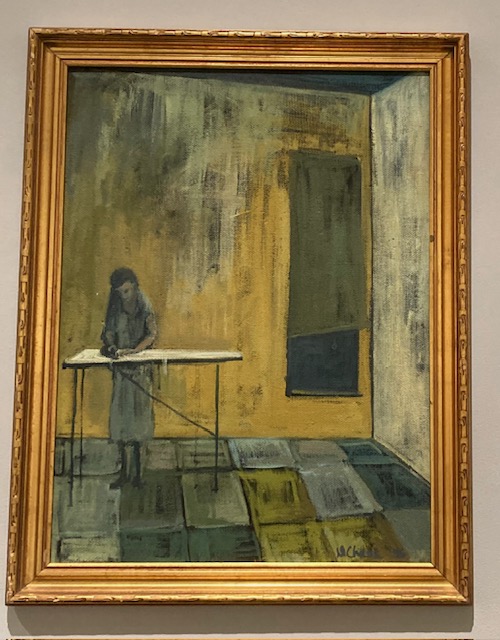

August 21 Mukilteo – “I kept wondering why wasn’t Persephone around,” Cousin Veronica said to me over lunch. She grew up in Tacoma and we often spent time together during the summers at our grandmother Abbott’s house in Parkland. We jumped over the aluminum sprinkler set out on the lawn in the backyard on hot afternoons. We ate tuna fish sandwiches on white bread and were permitted a small package of chips on the side. Sometimes a ginger ale. We worked on jigsaw puzzles laid out on a card table in the breakfast area of the kitchen.
There’s the hundred thousand dollar question. Where was I in the 1980’s? I was being distracted. I was being sent on AFS exchanges, to enact the role of a stranger sitting at other people’s dining tables and temporarily calling them family. All at once, I was regularly being driven to church by my mother on Sundays in California, after years of religion being completely dismissed as nonsense. As a teenager I was trying to cope with being cut off from family in Washington, the family I knew, and I was losing my mind but by hook and crook my grade point average was more than decent. I was admitted into Oberlin. I sank like a rock at that place. Undiagnosed autistic and stuck in a small town, I was supposed to network my ass off to set up my social circle and net-worth. I couldn’t manage the study load, I learned just about nothing because nothing made sense. One semester I turned all my furniture upside down in my dorm room and sat in the dark. I made some friends but I avoided social gatherings.
After years of being forbidden to talk about my lost family members by my mother, at Oberlin I found myself being sent by my parents to a completely new set of relatives on my father’s side in Minnesota for the school breaks. They were very decent and intelligent people and deep down I trusted no one. Back in Tacoma, no one was explaining anything to Veronica.
Our grandmother Abbott died in the spring of the last year that I was still enrolled in Oberlin and I didn’t attend her funeral. It was the time of crunch, the finals. My parents asked me about it, after years of not allowing me to see either my grandmother Abbott or my grandmother Hansen, and alarm bells started ringing in my ears. After seven years absence, I didn’t dare show my face at Grandma Gert’s funeral. I felt such shame and confusion. Somehow I had failed and I didn’t know what to do but say no. My parents seemed relieved. I was surprized they had asked.
Actually, what I know now was that at age twenty-one I was having a nervous breakdown. It was certain that I was not going to graduate and somehow I knew I was on my way to someplace outside the USA to escape what surely wasn’t going to be a promising future. In America I repeatedly dreamt I would be shot in an alley and left for dead. Looking back I probably wasn’t theorectially wrong, and it was most likely someone near to me who would be holding some kind of weapon at my head.
“Let’s go down this gulch,” I said to my cousin after lunch at Ivar’s in Mukilteo. Well, I didn’t say those words exactly but I said, “Come on.” And we headed into the woods down a muddy path. We didn’t say much more to each other but enjoyed the silence hanging in the air between the tall trees, the high ferns, the fungi growing on the trunks of trees, and the sound of the gurgling stream next to us. We came to a clearing where a railroad track lay in front of us. We followed the tracks back up the hill to the parked car.
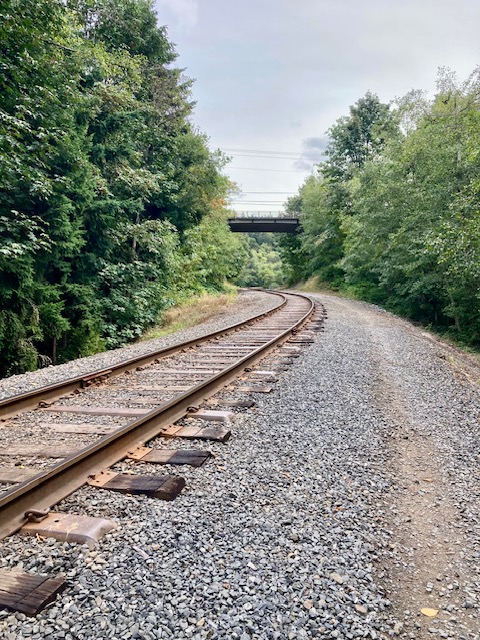
August 20 Tacoma – “Can I help you?” The man stopped his golf cart. I was wandering around the middle of the cemetery section. I had nearly gotten stuck in a rut at the back side of a cemetery building in an attempt to reverse the rental car. I was still jittery about that.
“Yes,” I said. He kindly helped me find my grandfather’s grave. Lloyd Hansen died in 1977. I didn’t attend the funeral. Nor did my parents. To this day I cannot explain why we were not at the funeral.
“Your grandfather died,” my mother had told me coldly, lying on the couch and picking at her fingernails. I cried and was confused. My parents didn’t think this was a sad event. And then nothing happened.
“Let me remove this blackberry vine,” the man said. He knelt down and took out his knife to cut the bramble away from the top right hand corner of the gravestone. I was touched.
Lloyd was buried near his parents. I stood at his father’s grave. His father died in 1955. In a strange twist of events, I have gotten to know Harald B. Hansen whose life ended more than a decade before I was born. It was my mother’s insistence on creating a new (false) identity for her grandfather that led me to Northern Norway and a clean up of the misinformation. I read family letters that he sent home to Norway. In one he expressed his regret at leaving the island at eighteen (changing Harald to Harold) and wished that things could have been different. A few years before her own passing, Harald’s mother sent him a plaintive letter, asking him when he was coming home and suggested bringing his wife with him up to a small island in the arctic circle to manage the family property. If there was one place that Harald’s wife was not going to go to, it was a small island in the arctic circle. She and her siblings had escaped farm life in the Midwest to the urban center of Seattle. Tressa liked gardening, playing canasta and wearing her false pearls.
Tressa loved her son and was not a compassionate mother-in-law. She regularly stopped by her son’s house to check up on Hannah’s housekeeping. My grandparents eventually moved to the “country”, a house on a lane outside the city areas of Tacoma. Just a little bit further that made it a little harder to justify “just stopping by”.
I drove past Harald and Tressa’s house on A Street. Lloyd had designed his parents’ house himself. It was odd to sit across the street in my rental car looking at my grandfather’s brain in the form of a house.
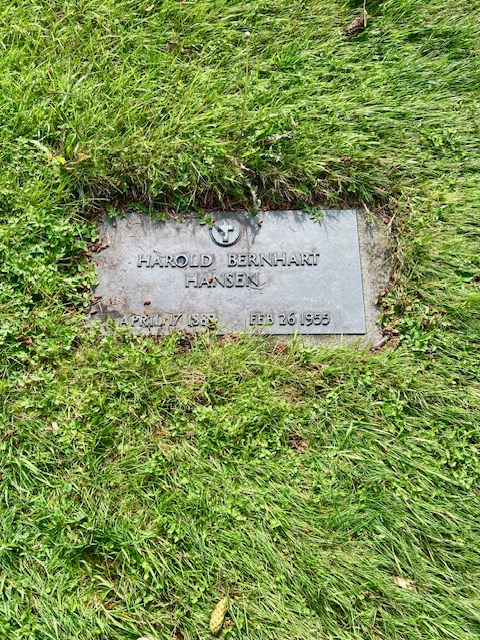
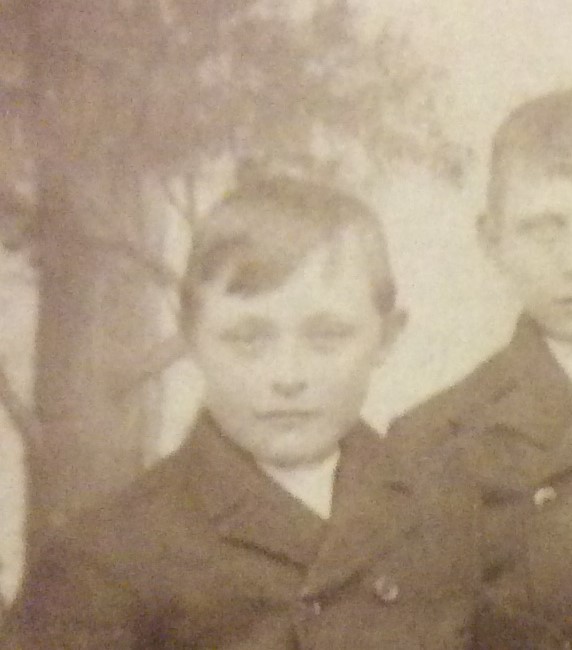
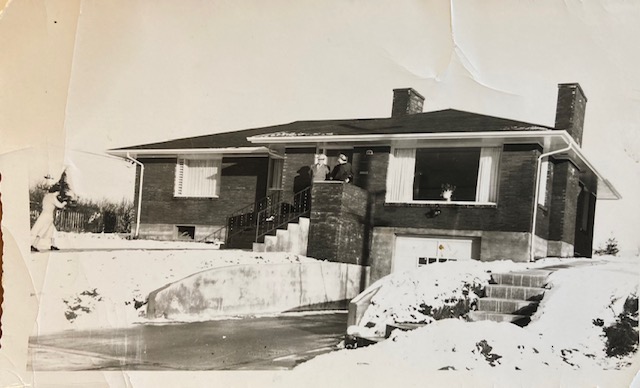
August 20 Tacoma – “Dad later bought the building next door. It used to be an ermine factory.” Aunt Judy said.
“The white brick building?” I asked incredulously, thinking of the feedmill’s silos and community of roosting pigeons along the rooftop. And the trains still rolling past on the railroad tracks that passed along the mill with a line of track that swerved to service the mill. All those little animals, living next to the train crossing and bred for their pelts.
“Yeah,” she replied.
We were talking about X-Cel Feedmill, the company Leonard Abbott Sr began with his friends after he retired early from the Sperry Flour Mill. I never met my Abbott grandfather. He died twelve days after I was born. He died in Tacoma and I was born in Monterey.
A heart attack took him, violently and swiftly. Unable to grasp what had happened, my grandmother kept asking when he was coming home. We drove by my Grandma Gert’s house. The lawn and grounds were no longer well cared for. Grandma Gert kept a clean and tidy house and garden. It was a calm environment and a place that I remember as a child as being soothing and pleasant. Reading my father’s book Racer, I instantly recognized that he used his mother’s house for one of the storylines.
The Abbotts bought the one-story house after years working on the farm in Parkland where all the children had to pitch in with the chores. Eventually my grandfather retired from General Mills, for the Sperry Division in the Feed Mill that produced animal feed for farms, and began his own feedmill. Gert’s dream was to have a modern home and she finally got her wish. She kept a framed photo of Grandpa Leonard next to her bed. She never spoke much about him to me and I remember her protective reaction when I asked her about the photo.
“Dad used to take me down with him on Saturdays to the mill,” Aunt Judy said. She meant Sperry Flour where my grandfather had worked his way up through the ranks. “Sometimes he had things to finish. It was such a treat to go with him. I found it very exciting.” We were standing in the Tacoma historical museum and looking at the model trains that were barreling around the miniature version of Commencement Bay. The Sperry Flour Mill was torn down in the 1970’s. It now only exists in a small scale version.

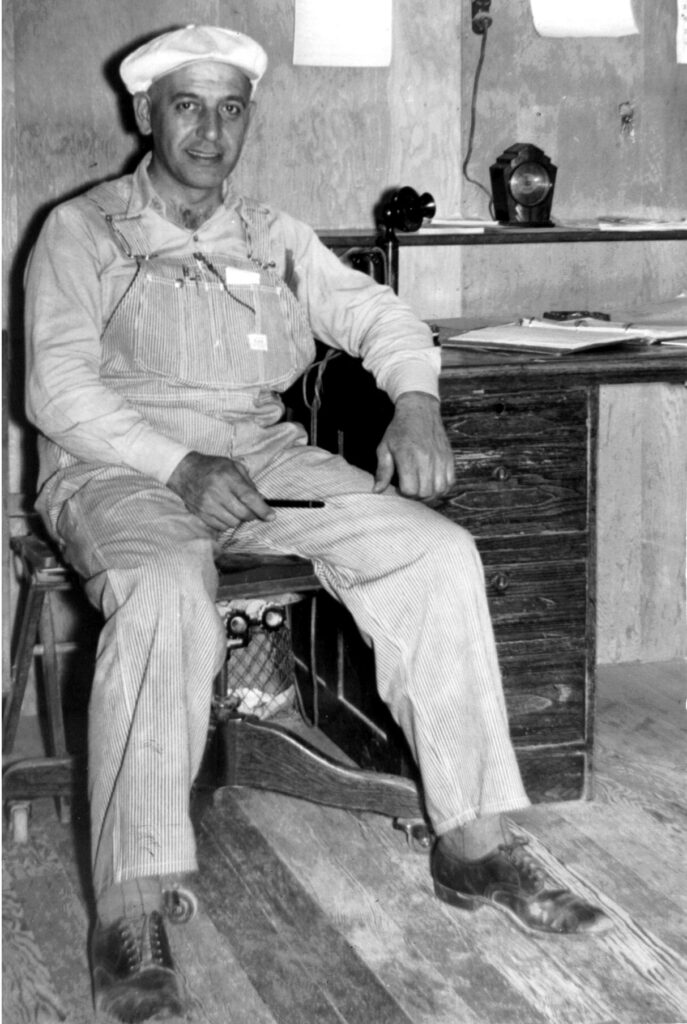
Tacoma August 19 – My grandmother Hannah Hansen married into a Lutheran family. She came from a Mennonite family background that had merged into the Baptist and Methodist establishments. I happen to have a cookbook at home from the Bethlehem Lutheran Church of Tacoma. My great grandparents, Harald and Tressa Hansen, were members of the church when they lived on A Street. My grandparents and their three children also attended services at the Bethlehem church into the 1950’s.
Time after time I have inspected family photos taken at the Bethlehem Lutheran Church in front of the building where Hannah is wearing a chic dress, looking radiant. Photos that imply a fairy tale American vein of life that I, born in 1967, had missed but had somehow re-lived it through the Barbie doll and clothing collection that had been my aunt’s, carefully stored in its original case for the next child which had been me, the only granddaughter. And having recently reviewed the line of cupboards, now empty, in a row alongside the upstairs hallway where all the toys had been kept in the original boxes in my grandmother’s house, I felt that curious feeling that I grew up with overcome me once again. The feeling is something along the lines of being connected to the generations before me by a kind of ghostlike activity.
I had never gone to a service at the Bethlehem Lutheran Church. Or at least, I don’t remember going. My parents were not enthusiastic about religion at all when I was young and Hannah as a rule didn’t take me to any church because she didn’t want to upset my parents. I figured it was about time I saw the place for myself so I checked the service times online: 9:00 am. I wondered what was up with that. The parking lot was out back and the back entrance was open.
“The Samoans are helping keep up the building.” J. told me as we sat in the pew. “They’re wonderful people,” she added. I considered this statement about the Samoans being wonderful people. It’s a kind of obligatory statement that I recognize. It’s the pan-USA one that says, “hey, no racism here and we recognize those people as a group”. I know it well. And the former part of that information clarified the 9:00 am start time. Gotta clear out by 10:00 for the Samoans. As for the non Samoans, there weren’t many and the worshippers who were there at 9:00 am are people at a stage of life that don’t mind an early start to Sundays. Everyone was fine with the plan.
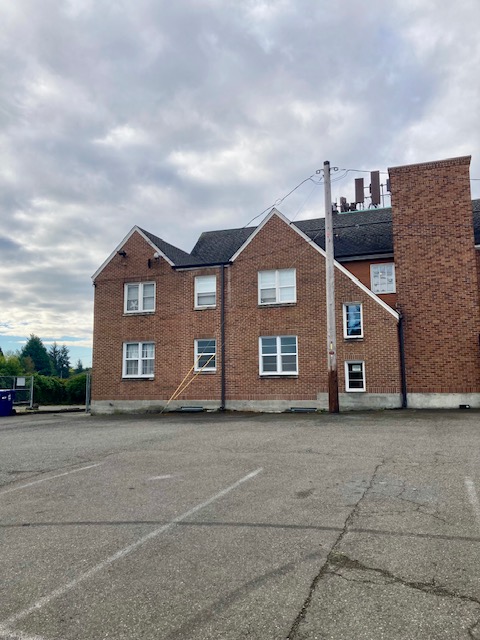
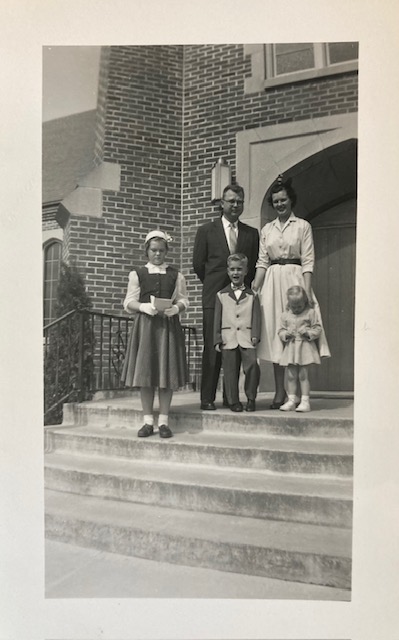
Tacoma August 18 – “Yeah,” the real estate agent said to me, “That closet does smell sweet. I wonder what it is.”
We were standing by the bathroom door which was flanked by two closet doors. I wanted to say, “Shalimar” which was my grandmother Hannah’s signature perfume. The cupboards were empty but the closet still smelled like my grandmother who had moved out of the house forty-one years previously.
I myself hadn’t set foot in the house for over forty-four years. I was now back in the area on a visit and I noticed a For Sale sign as I drove by. I requested a viewing. Posing as a buyer I inspected the vestiges of my childhood. The doorknobs, the closets, the smells, the views. I enjoyed the visit. The house was light inside and I pictured my grandparents reviewing the property in the early 1950’s and making the final decision to buy it. How they would have been delighted to purchase a modern brick house (only twenty years old at the time) and not one of the creaking wooden houses that were so prolific to the area.
Although I only have fond childhood memories of the house and staying in the house, the events of the last forty years and the ensuing trauma cast quite a shadow on my memories. When the real estate agent was out of sight. I charged up the stairs like I did in the past and felt myself arriving back to the core of me.
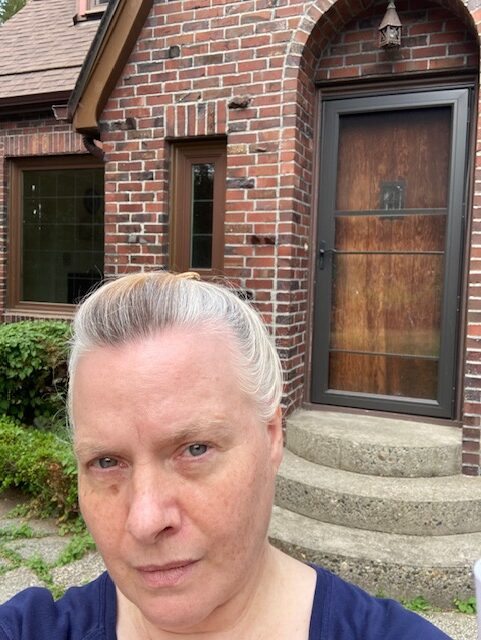
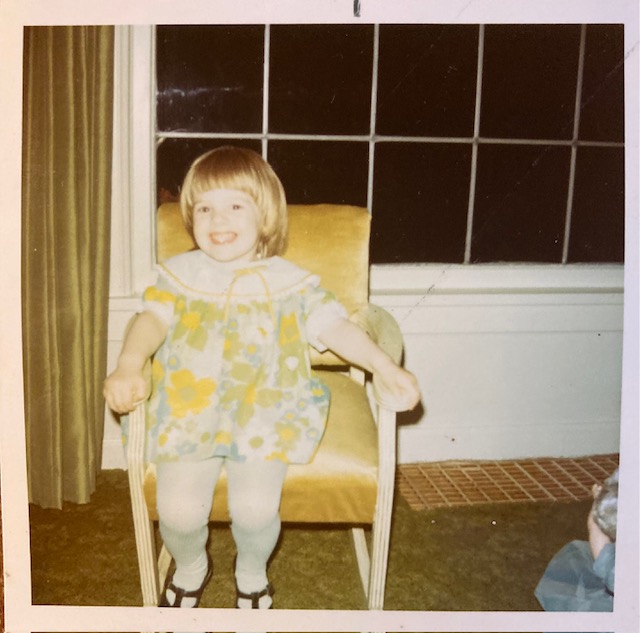
Tacoma August 17 – It’s 4:45 am in Tacoma and I am contemplating Cheerios. Usually when I come to the states and I am grocery shopping, I think whatever and I don’t try to find the lowest price for items. Besides, the experience of grocery stores in the states is almost like going to Disneyland and why spoil the fun by counting pennies? But this time I decided I’d make the effort. You might have heard about the price difference between grocery shopping in the Netherlands versus the USA. Yeah, well it’s more like counting dollars than pennies.
I still had energy after the long flight so I headed for a Dollar Store. I was greeted by a faint voice saying welcome from the direction of the checkout stands. When I turned my head in response I noticed there was a tall, thin homeless man standing next to the nearest checkout stand. I was slightly disorientated by this juxtapostion of sight and sound and I immediately wanted to vere off into the Halloween section. But I stayed my course. Cereal. I wanted to find cheap Cheerios like that YouTuber I saw last week, opening up her plastic bags for the camera and showing off her bargains from the Dollar Store. Okay, so I am not watching sensationalist videos on YouTube. However, there wasn’t much to be found on the shelves.
This Dollar Store that I am standing in, I thought as I reached for my cars keys, might not be in the chic area of town. I gave up and went across the street to Safeway. No Trader Joe’s in sight. I looked at massive peaches in the produce section at Safeway and wondered if they actually tasted like peaches. I found Cheerios. All sorts of Cheerios. I spotted an Apple Cinnamon version. I stood there perplexed in the cereal aisle at so much choice and remembered there was that time that I arrived at my grandmother Hannah’s one summer and she had, at my request, bought Apple Jacks. I can’t eat Apple Jacks now because of the gluten, but I thought I’d give these flavoured Cheerios a try. Just to see what comes to mind. It might be Proustian experience on the wings of jetlag.
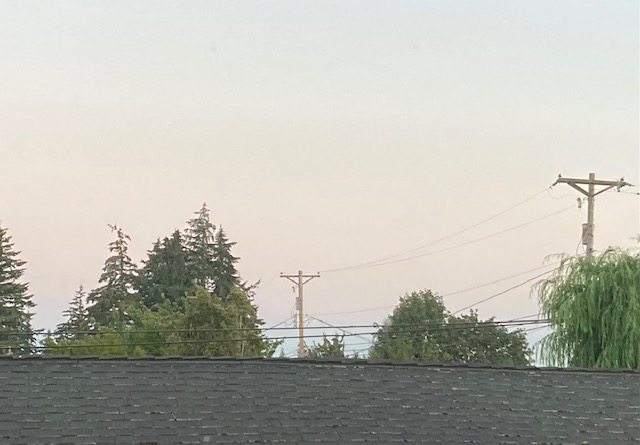
Amsterdam August 16 – You know how you just start throwing stuff in a suitcase? Well, I certainly know about randomly throwing stuff in a suitcase. And this after a colleague was telling me about a great packing system that reduces space in suitcases. And, of course, I nodded as she kindly explained and demonstrated this item, all the while knowing that I was going to just toss things over my shoulder as I went through my apartment and hope they all ended up inside the suitcase. I might have to check that super duper system out at a Marshalls or TKMaxx when I am in the states. But I am not sure this trip is just all about organizing physical objects.
Yesterday I said goodbye to my three day a week job. It was a great experience to work there for a year and a half and learn to use new software systems. I feel “updated”. And the people were really lovely. They organized a goodbye and presented me with flight snacks and a book certificate. (They truly got to know who I am and what I like.) But I did sense it was time to move on and besides I was also feeling the need to plan an extended trip to the states and so…yes off I go.